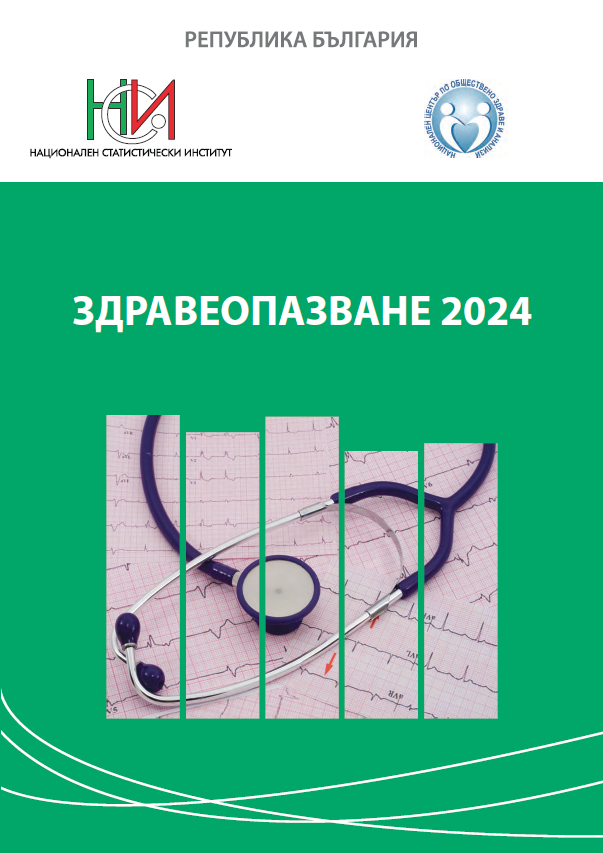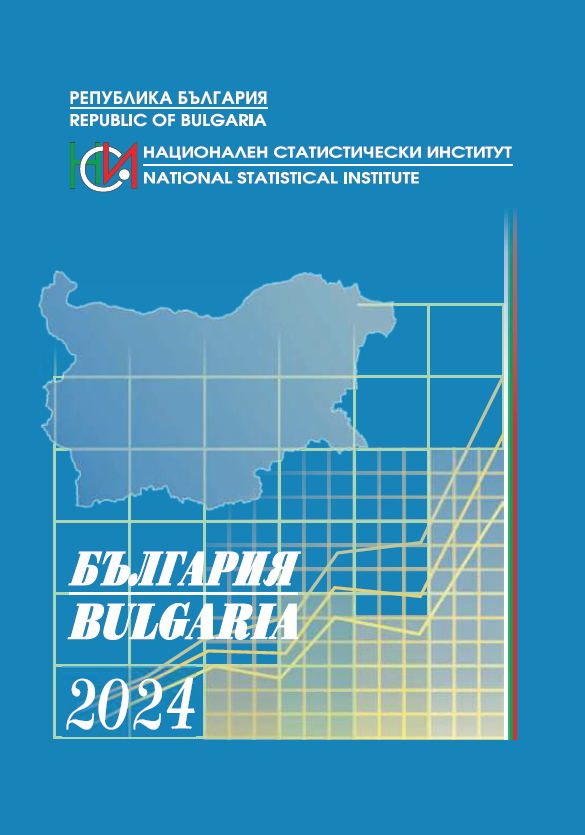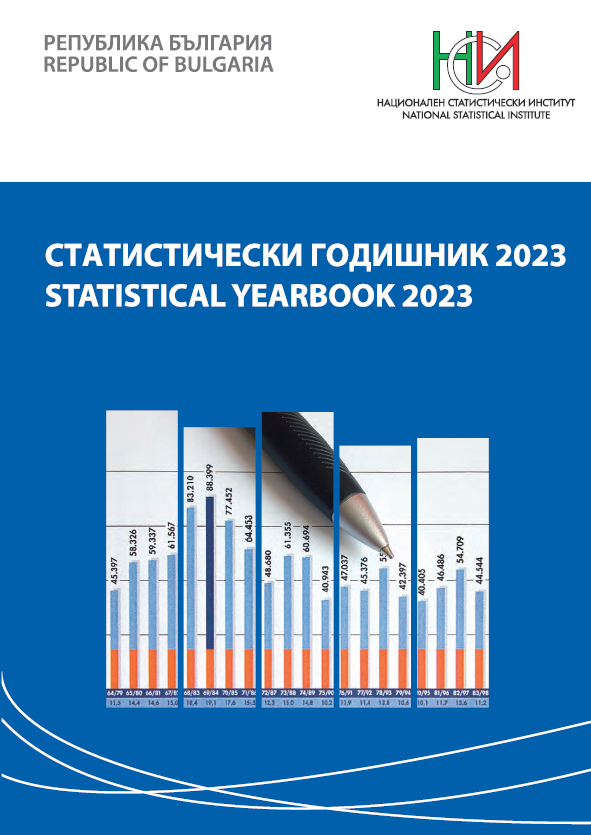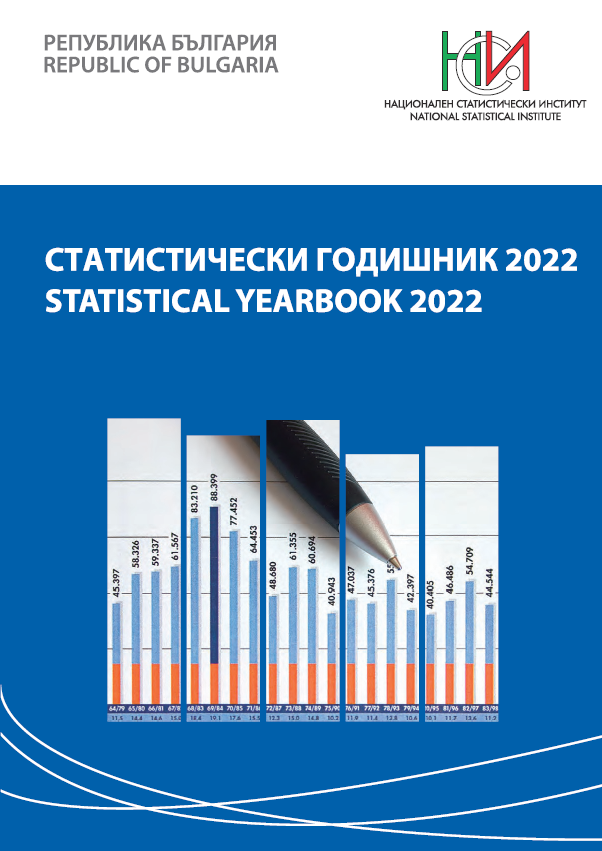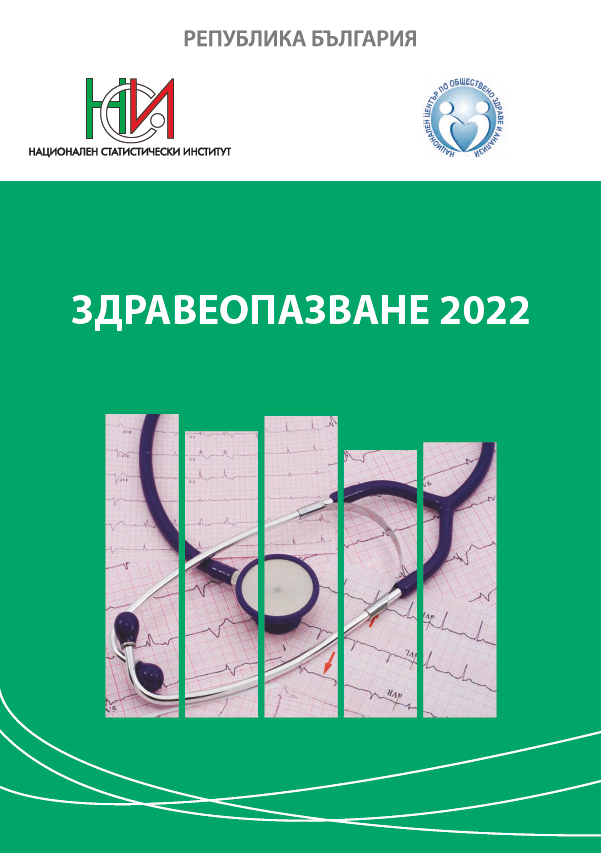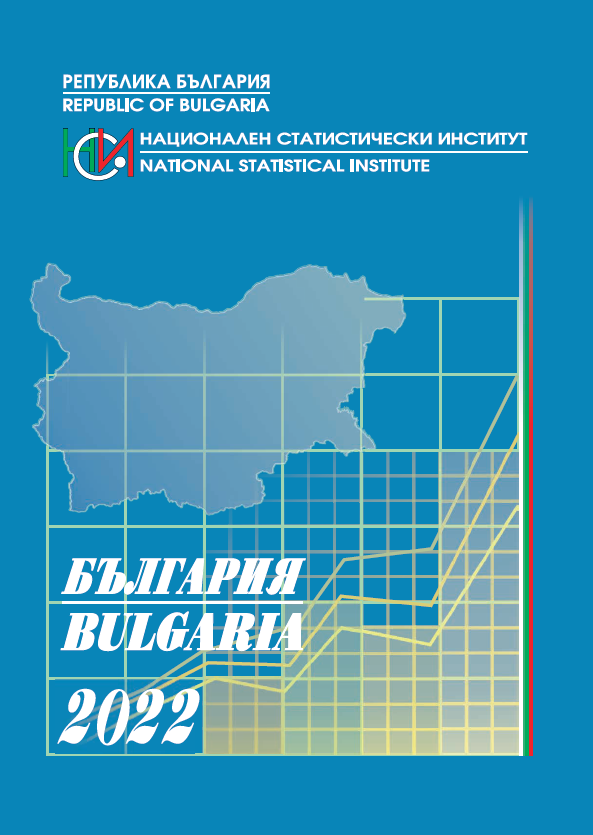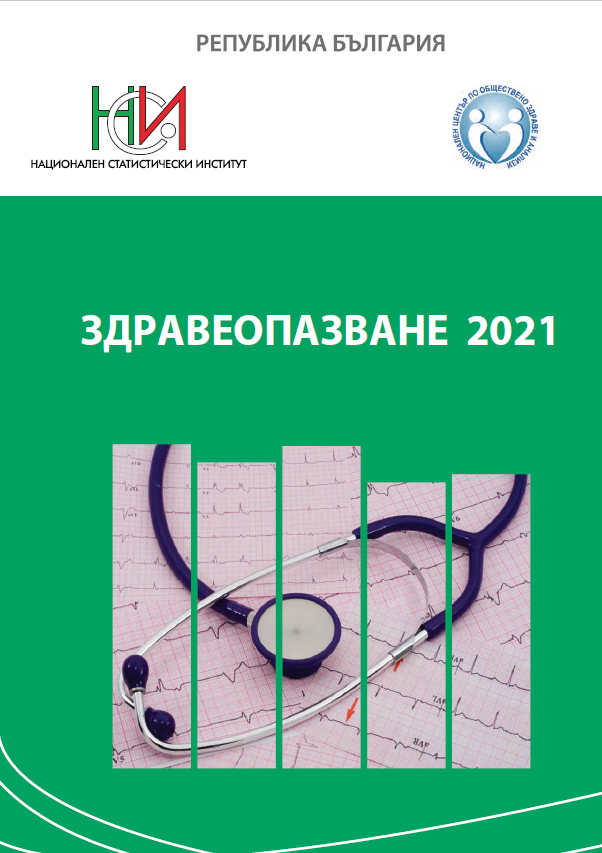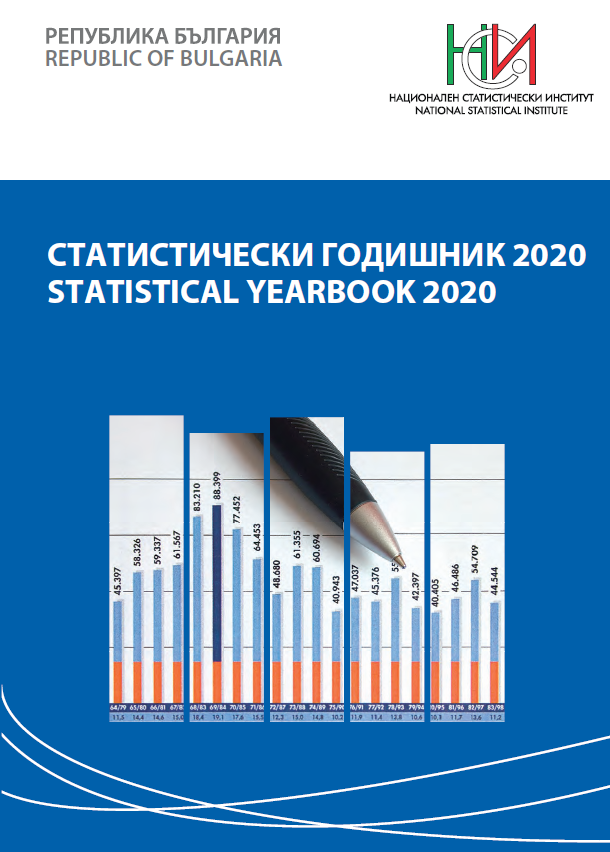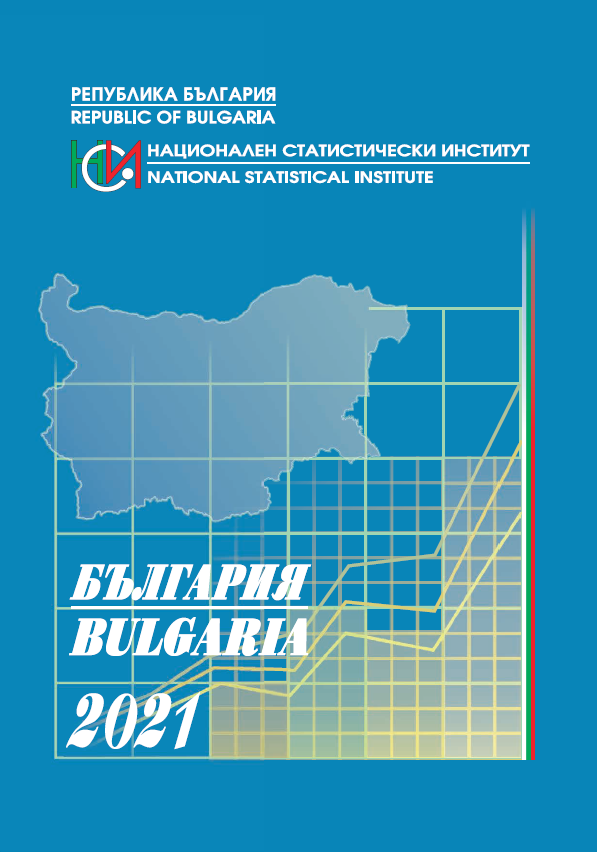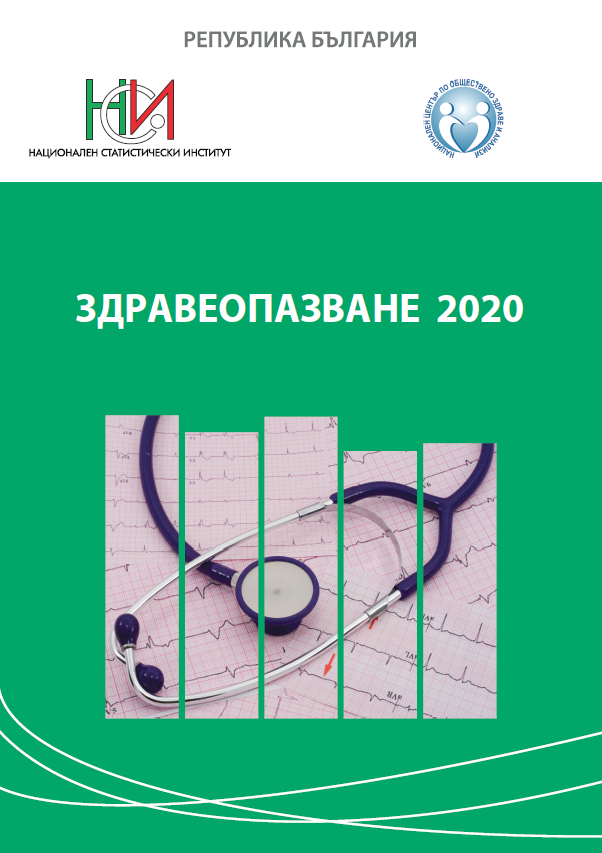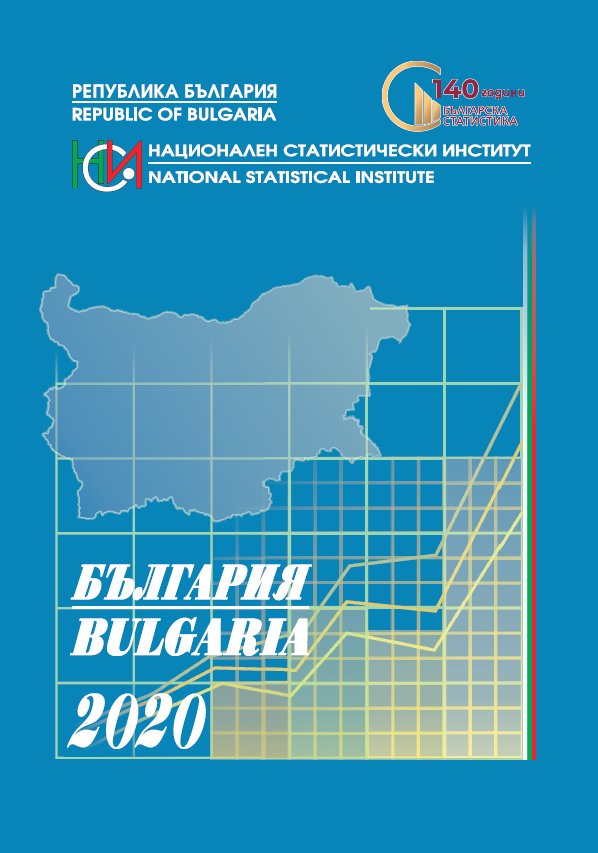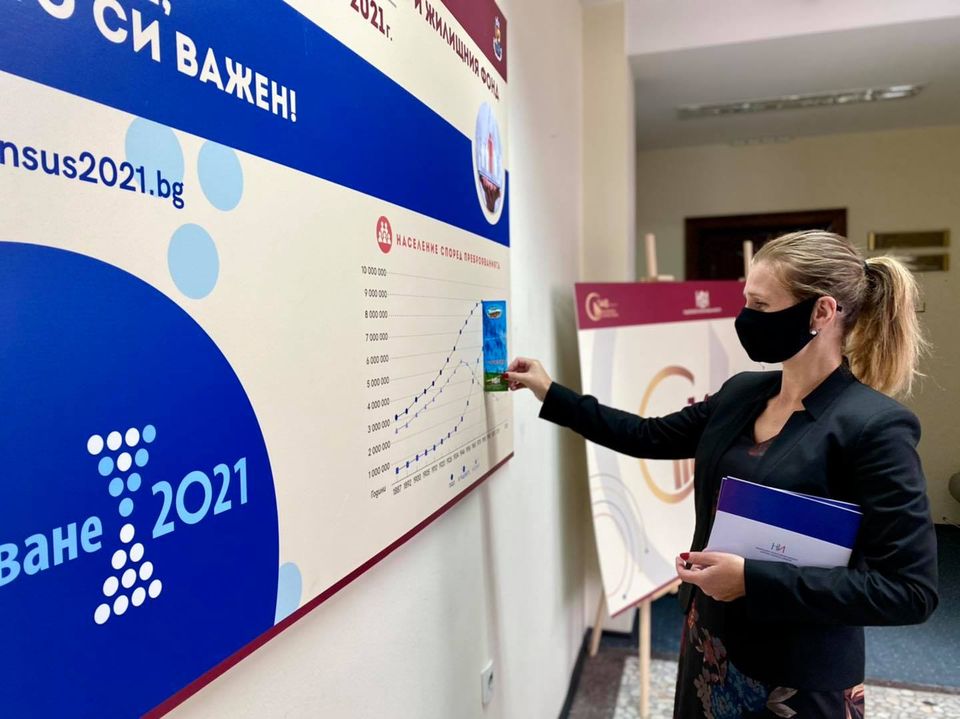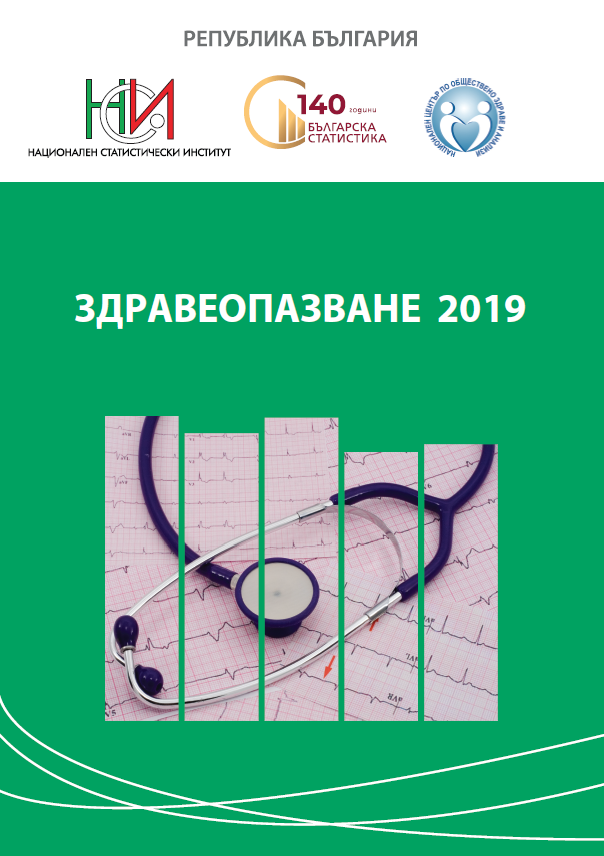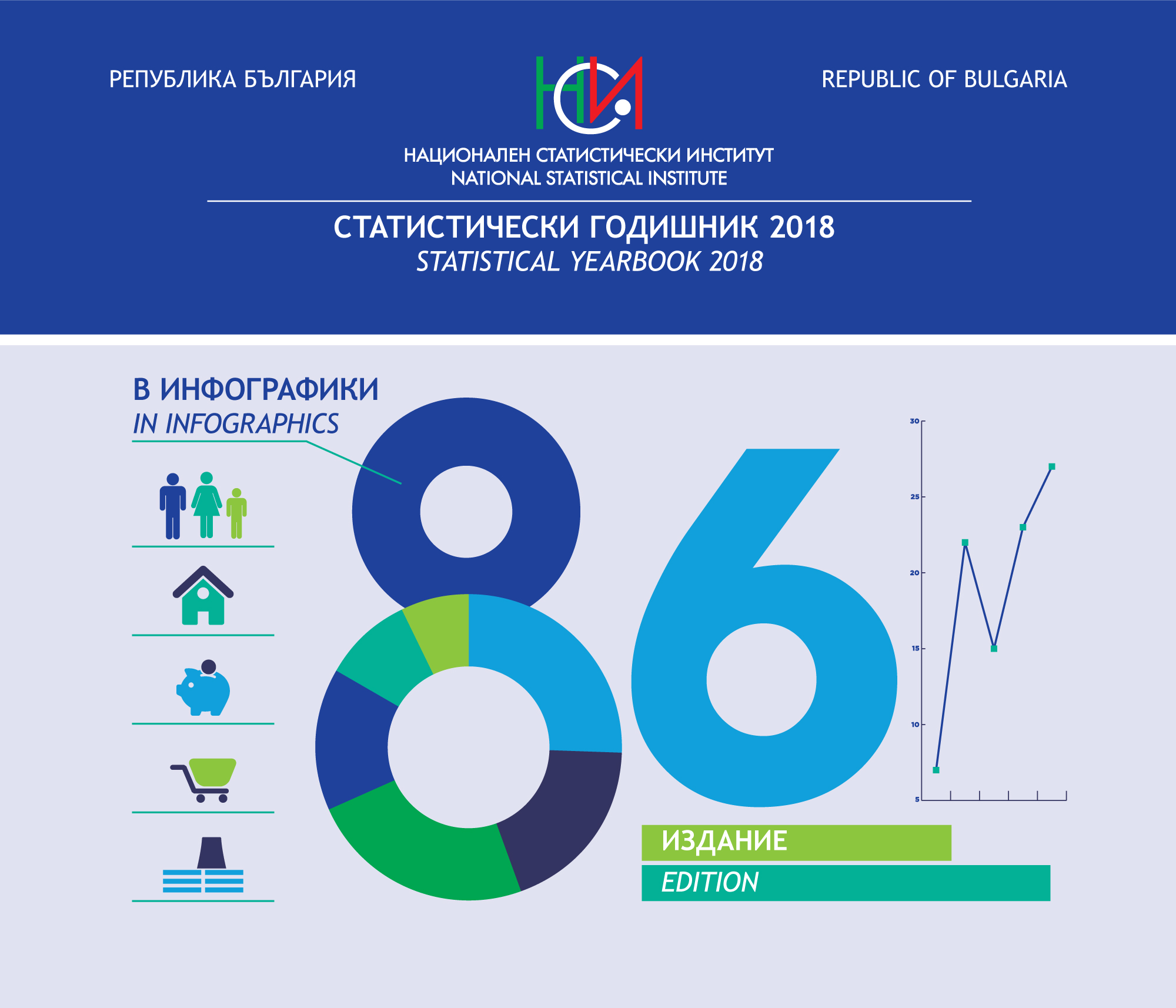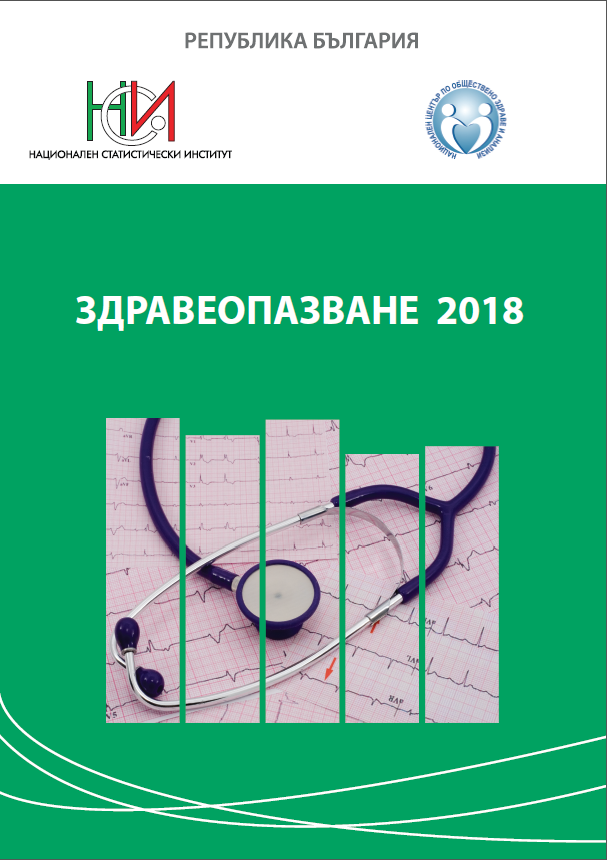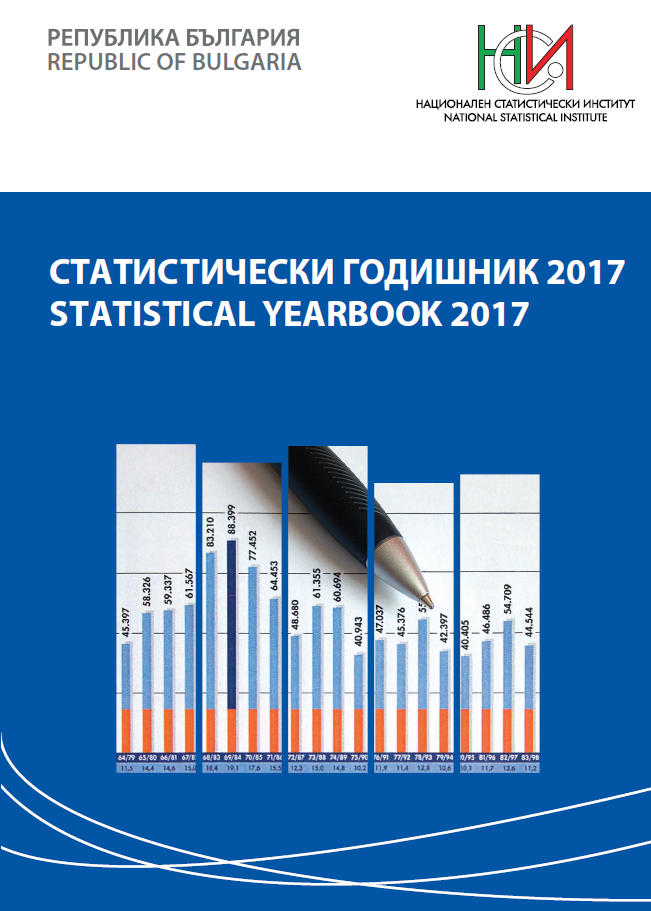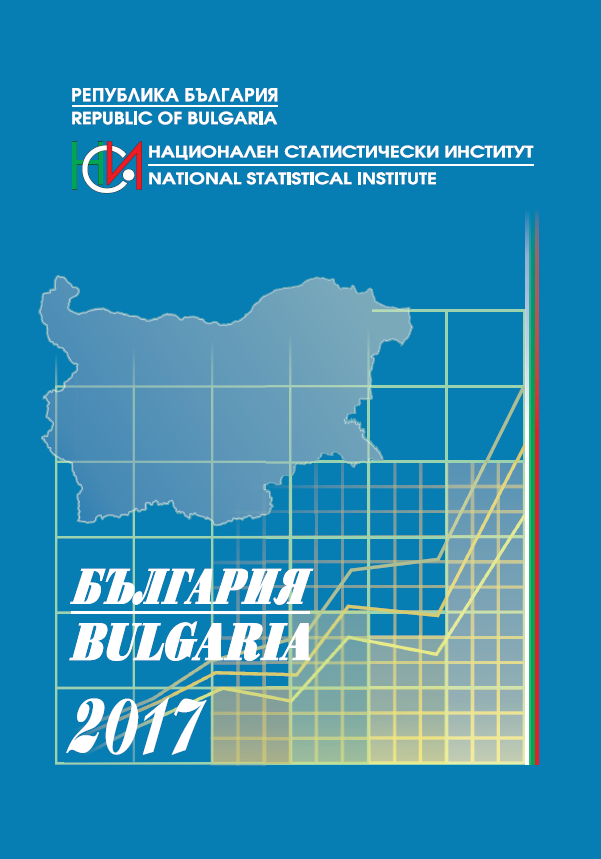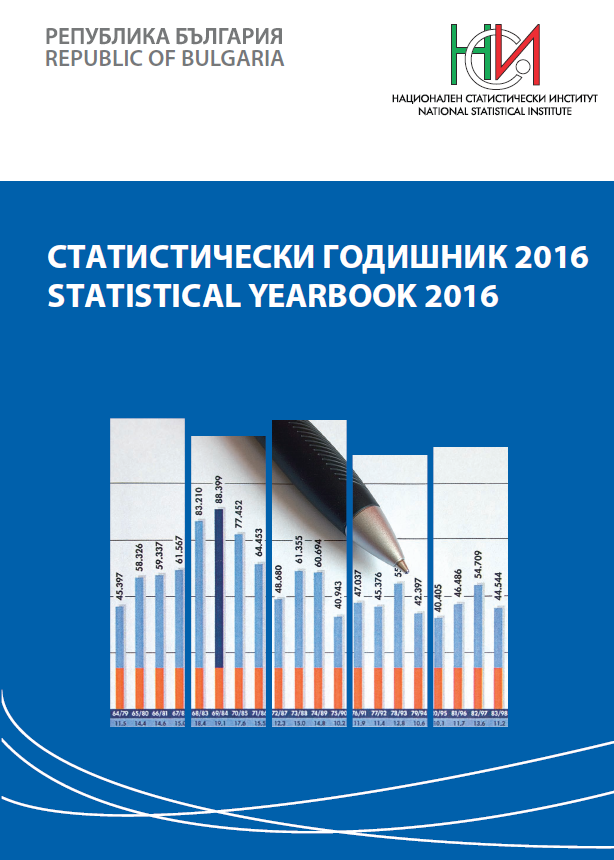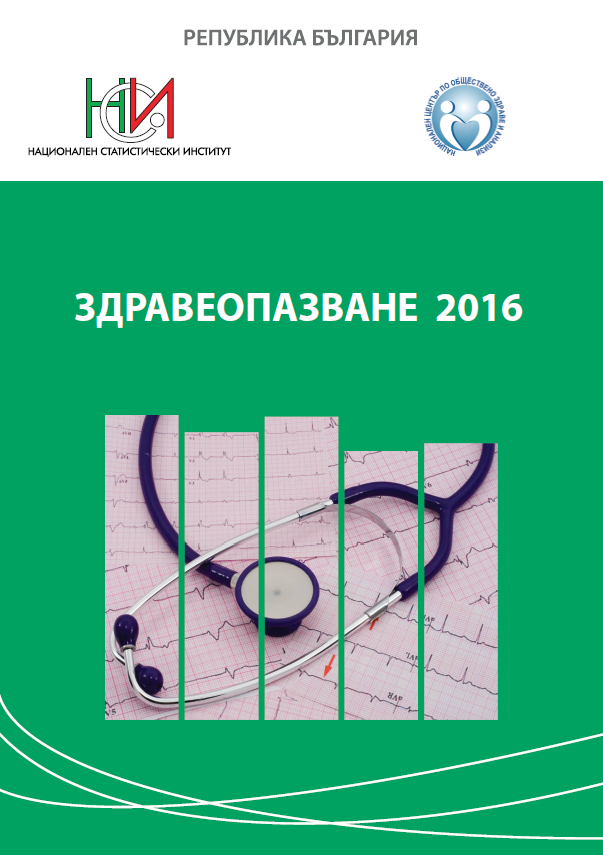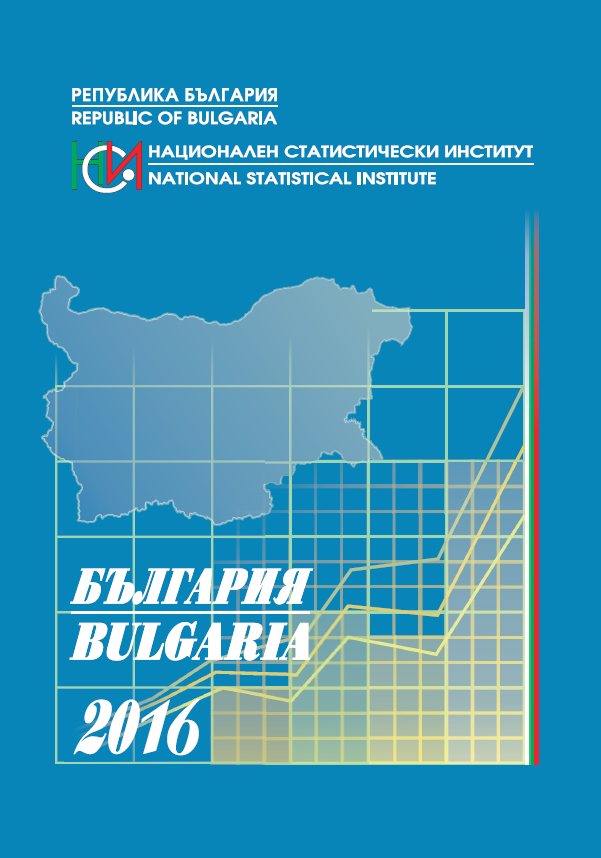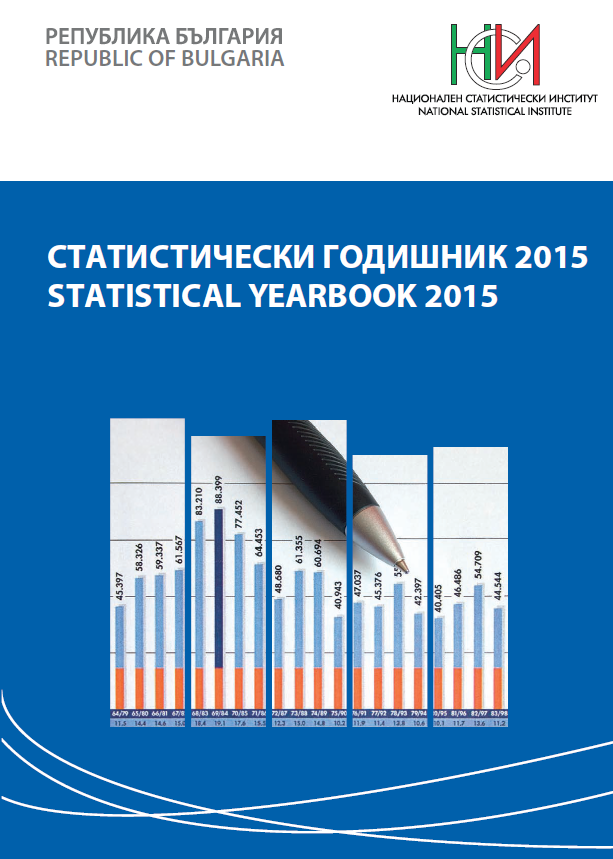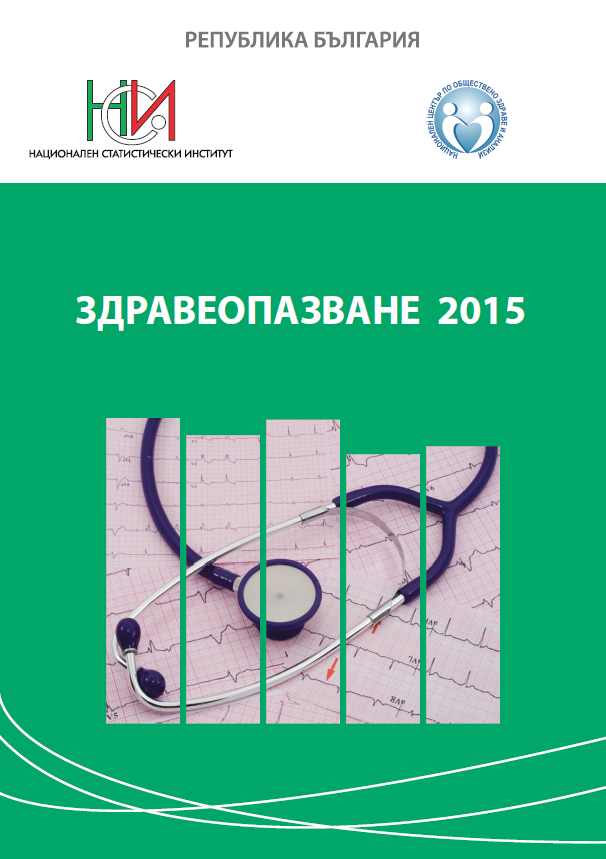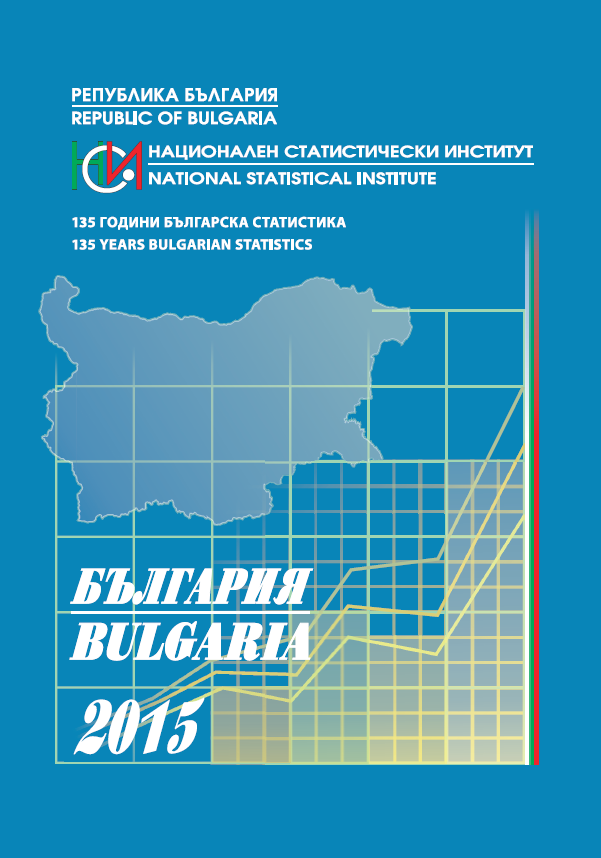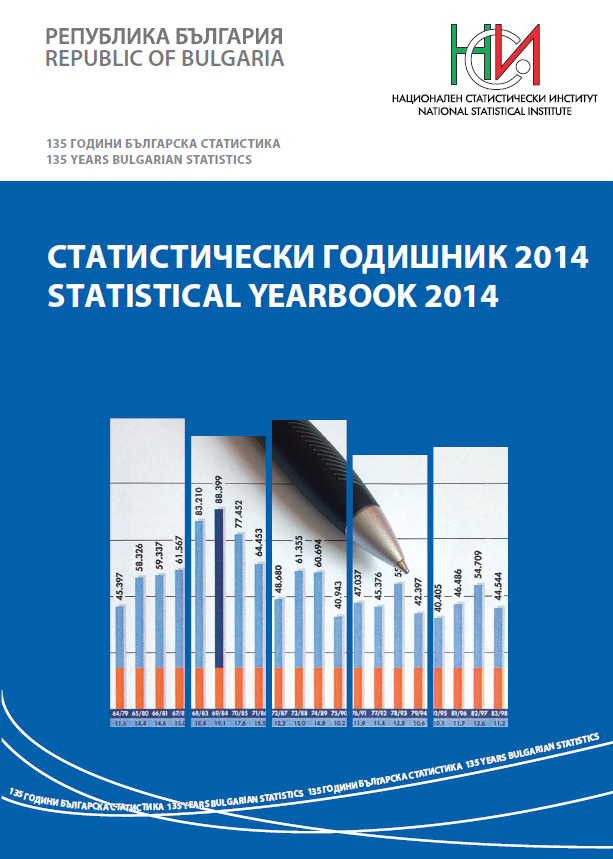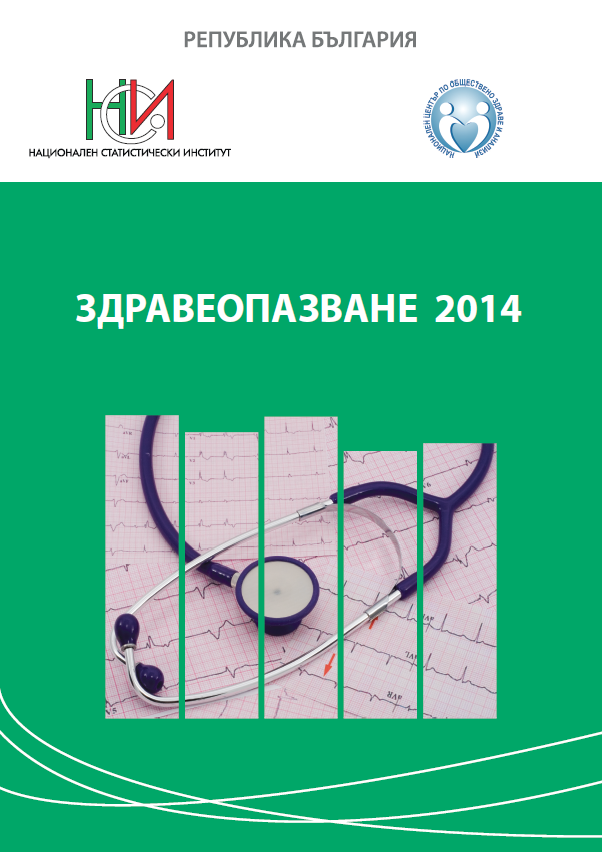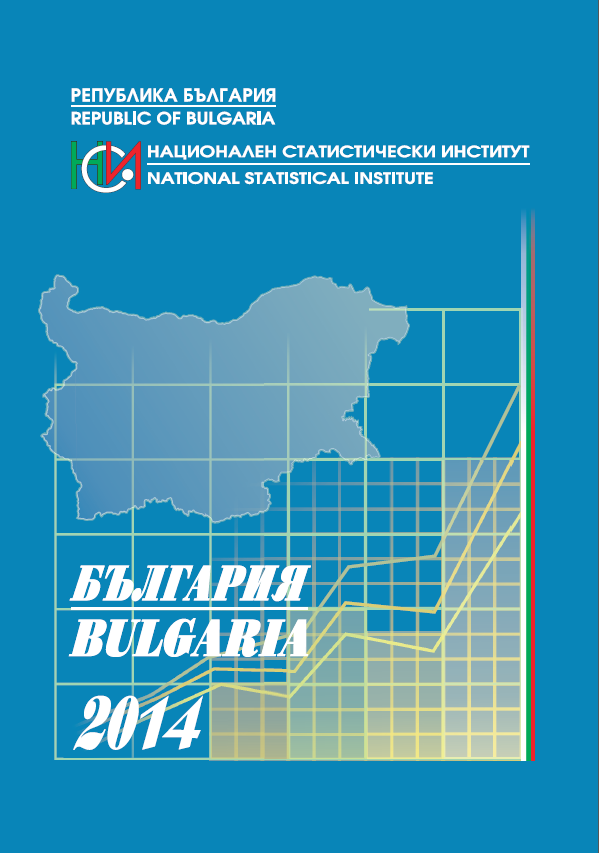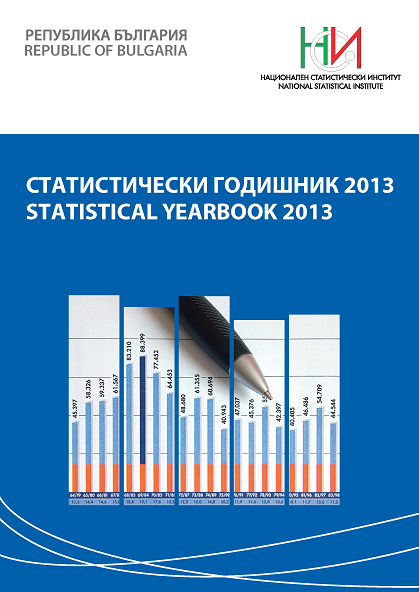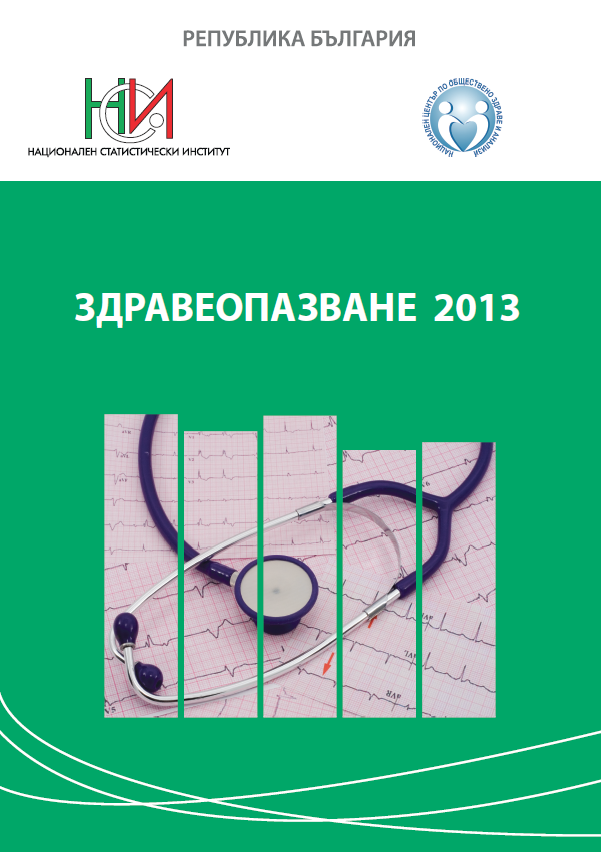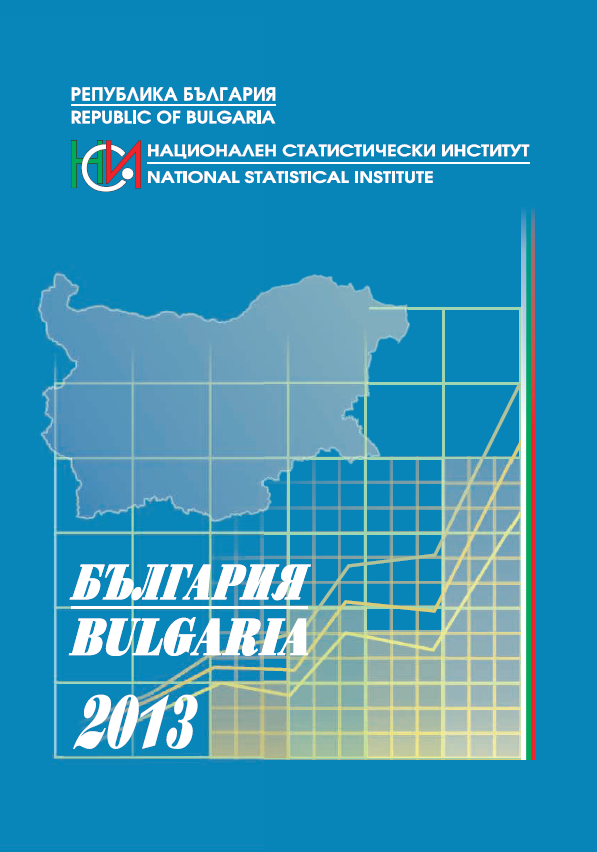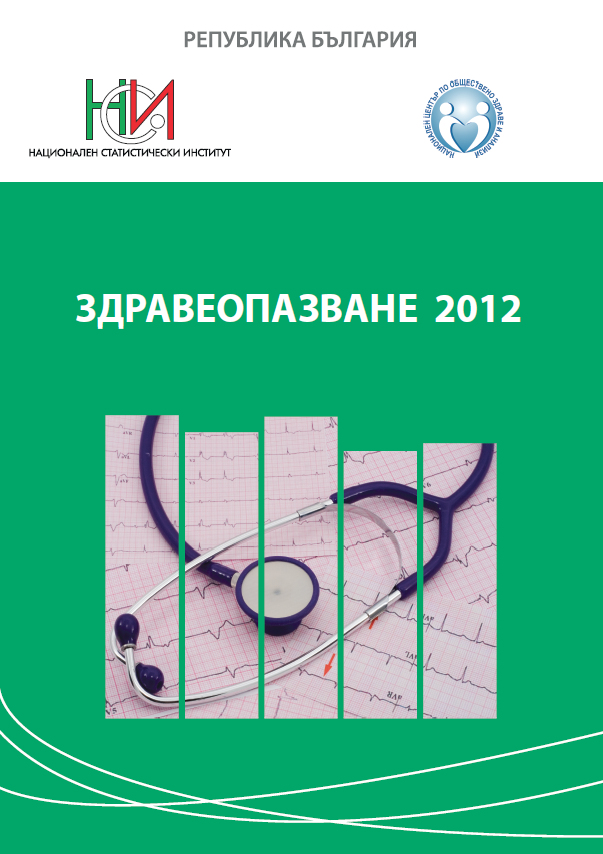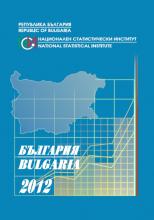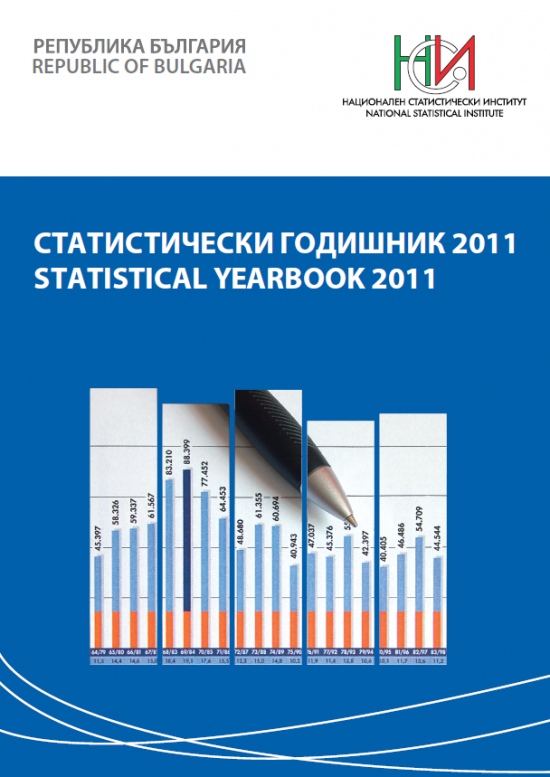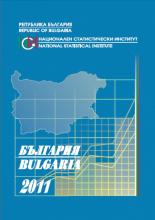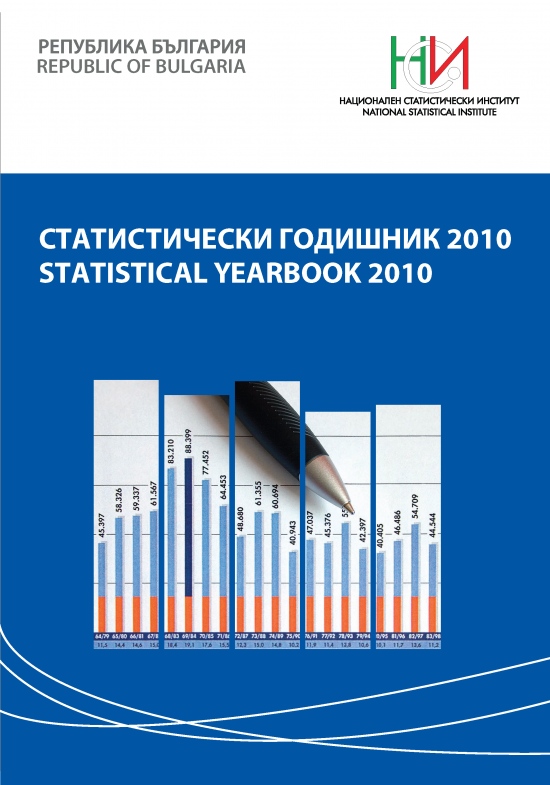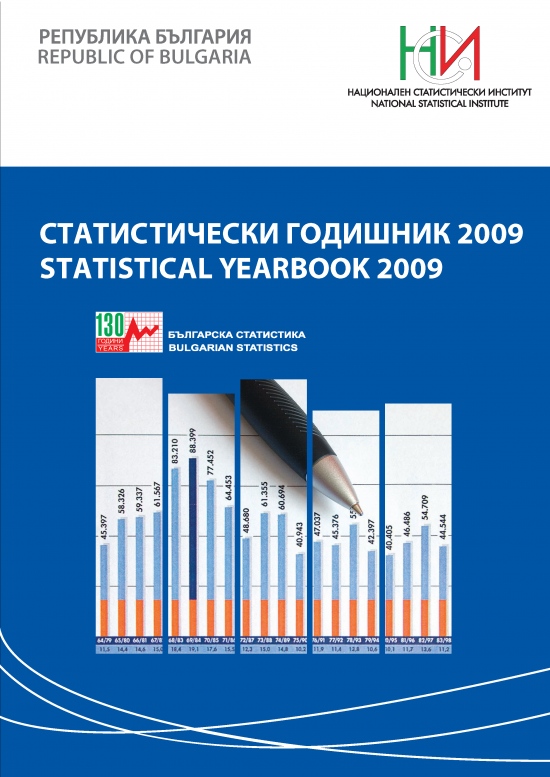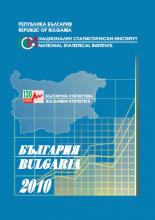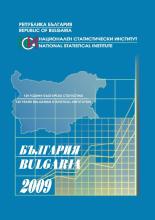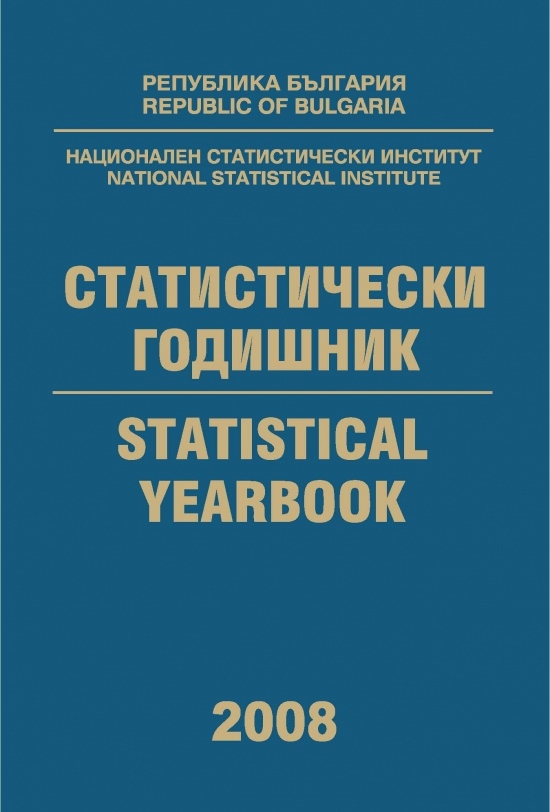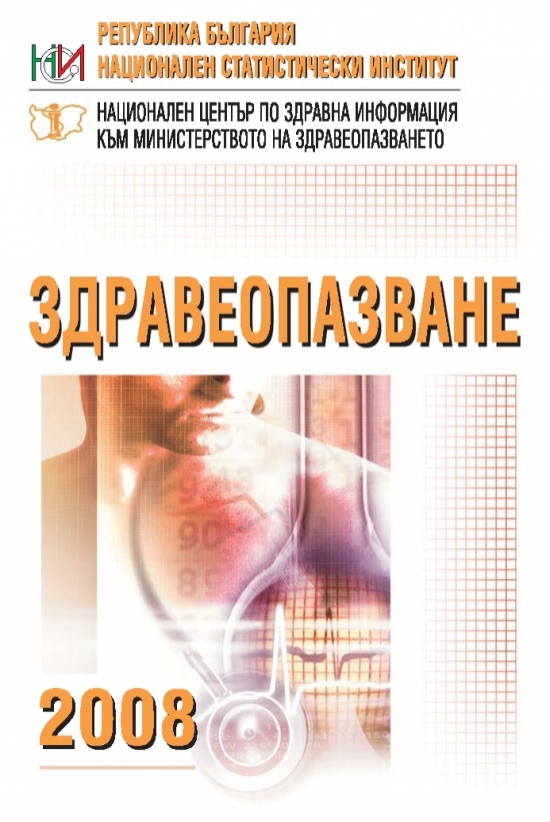Still-births by causes
Euro-SDMX Metadata Structure (ESMS)
| Contact | |||||||||||||||||||||||||||||||||||||||||||||||||||||||||||||
|---|---|---|---|---|---|---|---|---|---|---|---|---|---|---|---|---|---|---|---|---|---|---|---|---|---|---|---|---|---|---|---|---|---|---|---|---|---|---|---|---|---|---|---|---|---|---|---|---|---|---|---|---|---|---|---|---|---|---|---|---|---|
| Contact organisation | National Statistical Institute | ||||||||||||||||||||||||||||||||||||||||||||||||||||||||||||
| Contact organisation unit | "Health and Justice Statistics" Department | ||||||||||||||||||||||||||||||||||||||||||||||||||||||||||||
| Contact name | Evelin Yordanova | ||||||||||||||||||||||||||||||||||||||||||||||||||||||||||||
| Contact person function | Head of department | ||||||||||||||||||||||||||||||||||||||||||||||||||||||||||||
| Contact mail address | 2, P. Volov Str.; 1038 Sofia, Bulgaria | ||||||||||||||||||||||||||||||||||||||||||||||||||||||||||||
| Contact email address | |||||||||||||||||||||||||||||||||||||||||||||||||||||||||||||
| Contact phone number | +359 2 9857 459 | ||||||||||||||||||||||||||||||||||||||||||||||||||||||||||||
| Contact fax number | |||||||||||||||||||||||||||||||||||||||||||||||||||||||||||||
| Metadata update | |||||||||||||||||||||||||||||||||||||||||||||||||||||||||||||
| Metadata last certified | 28 June 2024 | ||||||||||||||||||||||||||||||||||||||||||||||||||||||||||||
| Metadata last posted | 28 June 2024 | ||||||||||||||||||||||||||||||||||||||||||||||||||||||||||||
| Metadata last update | 28 June 2024 | ||||||||||||||||||||||||||||||||||||||||||||||||||||||||||||
| Statistical presentation | |||||||||||||||||||||||||||||||||||||||||||||||||||||||||||||
| Data description | Causes of death statistics is widely used as a basic source of information for health status international comparisons as well as for national analyses. The one-type data collection procedures, unified death certificate and WHO International Classification of Diseases are used in all European countries. Since 2005 the International Classification of Diseases - X Revision is used in Bulgaria. The requirements of ICD X are elaborated in COD statistical work in Bulgaria. According to Eurostat requirements since 2014 the harmonised 86 causes list is used for development of statistical tables as well as for analysis. Data source on causes of death statistics is the medical death certificate. The form and the content of the document are determined by Ordinance № 42 of 8 December 2004 the Minister of Health, as part of the cause of death and other medical information is standardized in accordance with the recommendations of the World Health Organization (WHO). The death certificate is filled in by the physician who recognized the death. The coding of causes of death and stillbirth are carried out on a paper document by physicians working in Regional health inspections, specially trained to implement the requirements of the International Classification of Diseases - X revision and the Methodological instructions to Ordinance № 42 of 08.12.2004 of the Ministry of Health. Data are broken down by sex, age groups, type of the settlement and cause of death (by chapters of ICD-10 or in accordance with the harmonized European Short List of 86 causes) at national level and by statistical regions and districts in accordance with the Nomenclature of territorial units for statistics in Bulgaria (NUTS 2 and NUTS 2). Annual data are presented in numbers and per 100 000 of population. | ||||||||||||||||||||||||||||||||||||||||||||||||||||||||||||
| Classification system |
| ||||||||||||||||||||||||||||||||||||||||||||||||||||||||||||
| Sector coverage | The deceased persons who have the present address in the Republic of Bulgaria are included. | ||||||||||||||||||||||||||||||||||||||||||||||||||||||||||||
| Statistical concepts and definitions | In accordance with the requirements of WHO, statistical tables are elaborated based on the underlying cause of death, i.e. "the disease or injury which initiated the train of morbid events leading directly to death, or the circumstances of the accident or violence which produced the fatal injury". Four-digit code of ICD - X rev. is used. The cause of death frequency is the ratio between number of deaths by certain cause and annual average of the respective population. It is calculated per 100 000 of population. Infant mortality rate is calculated per 1000 live born. | ||||||||||||||||||||||||||||||||||||||||||||||||||||||||||||
| Statistical unit | The statistical unit is the deceased person. The reporting unit is the physician who filled in the death certificate (certifier). The events are registered by following document:
| ||||||||||||||||||||||||||||||||||||||||||||||||||||||||||||
| Statistical population | The deceased persons who have a present address in the Republic of Bulgaria are included. | ||||||||||||||||||||||||||||||||||||||||||||||||||||||||||||
| Reference area | Covered by the territory of the Republic of Bulgaria. The regional data is according to the administrative-territorial division of the country as of 31.12. of the reference year. | ||||||||||||||||||||||||||||||||||||||||||||||||||||||||||||
| Time coverage | By 1994 - only published data. 1995 - 2004 - the data are available on request. 2005 - 2023 - the data are available on the website www.nsi.bg | ||||||||||||||||||||||||||||||||||||||||||||||||||||||||||||
| Base period | Not applicable. | ||||||||||||||||||||||||||||||||||||||||||||||||||||||||||||
| Unit of measure | |||||||||||||||||||||||||||||||||||||||||||||||||||||||||||||
Number, per 100 000 of population. | |||||||||||||||||||||||||||||||||||||||||||||||||||||||||||||
| Reference period | |||||||||||||||||||||||||||||||||||||||||||||||||||||||||||||
Annually | |||||||||||||||||||||||||||||||||||||||||||||||||||||||||||||
| Institutional mandate | |||||||||||||||||||||||||||||||||||||||||||||||||||||||||||||
| Legal acts and other agreements |
| ||||||||||||||||||||||||||||||||||||||||||||||||||||||||||||
| Data sharing | Until 2010 data are provided to Eurostat and the World Health Organization in framework of joint data collection by single cause, sex, age, and statistical regions (NUTS 2). Since 2011 the data are provided pursuant to Regulation (EC) № 328/2011. | ||||||||||||||||||||||||||||||||||||||||||||||||||||||||||||
| Confidentiality | |||||||||||||||||||||||||||||||||||||||||||||||||||||||||||||
| Confidentiality - policy |
| ||||||||||||||||||||||||||||||||||||||||||||||||||||||||||||
| Confidentiality - data treatment | The level of detailing of the causes of death and preparation of statistics table data are in accordance with the recommendations of the World Health Organization. | ||||||||||||||||||||||||||||||||||||||||||||||||||||||||||||
| Release policy | |||||||||||||||||||||||||||||||||||||||||||||||||||||||||||||
| Release calendar | The date of the statistical information release is shown in the Release Calendar presenting the results of the statistical surveys carried out by the National Statistical Institute. | ||||||||||||||||||||||||||||||||||||||||||||||||||||||||||||
| Release calendar access | The calendar is available on the NSI website: https://www.nsi.bg/en/node/480 | ||||||||||||||||||||||||||||||||||||||||||||||||||||||||||||
| User access | Data on Deaths by causes and mortality by causes is published on the NSI website, section Health in accordance with the Law on Statistics and the European Statistics Code of Practice respecting the professional independence and aimed at objectivity, transparency and equal treatment of all consumers. | ||||||||||||||||||||||||||||||||||||||||||||||||||||||||||||
| Frequency of dissemination | |||||||||||||||||||||||||||||||||||||||||||||||||||||||||||||
Annually | |||||||||||||||||||||||||||||||||||||||||||||||||||||||||||||
| Accessibility and clarity | |||||||||||||||||||||||||||||||||||||||||||||||||||||||||||||
| News release | Not applicable. | ||||||||||||||||||||||||||||||||||||||||||||||||||||||||||||
| Publications |
| ||||||||||||||||||||||||||||||||||||||||||||||||||||||||||||
| On-line database | Data on Deaths by causes and mortality by causes are available to all users of the Online database of Eurostat. | ||||||||||||||||||||||||||||||||||||||||||||||||||||||||||||
| Micro-data access | Anonymised individual data can be provide for scientific and research purposes, and for individual request according to the Rules for the provision of anonymised individual data for scientific and research purposes. All data on causes of deaths are stored in a database "Demography". Access is strictly regulated in accordance with the rules on protection of personal data and protection of statistical secrecy. | ||||||||||||||||||||||||||||||||||||||||||||||||||||||||||||
| Other | Information service on request, according to the Rules for the dissemination of statistical products and services in NSI. | ||||||||||||||||||||||||||||||||||||||||||||||||||||||||||||
| Documentation on methodology |
| ||||||||||||||||||||||||||||||||||||||||||||||||||||||||||||
| Quality documentation | The quality of information on causes of deaths and mortality by causes are mainly determined by the information filled in by the physician as well as by the implemented rules for the selection and coding of the underlying cause of death. | ||||||||||||||||||||||||||||||||||||||||||||||||||||||||||||
| Quality management | |||||||||||||||||||||||||||||||||||||||||||||||||||||||||||||
| Quality assurance | Strict implementation of the WHO requirements and the rules and instructions for certification and coding according to ICD - X rev. Annual logical control of data quality in accordance with ICD - X rev. Implementation of the recommendations of Eurostat for quality control of the data. Integrated quality and security management system has been implemented in accordance with the requirements of BDS EN ISO 9001: 2015 and BDS EN ISO 27001: 2017. The certificate fully meets all international requirements and guarantees the quality of the processes and information security of the entire statistical and information infrastructure of the NSI, both at national and regional levels. | ||||||||||||||||||||||||||||||||||||||||||||||||||||||||||||
| Quality assessment | Integrated quality and security management system has been implemented in accordance with the requirements of BDS EN ISO 9001: 2015 and BDS EN ISO 27001: 2017. The certificate fully meets all international requirements and guarantees the quality of the processes and information security of the entire statistical and information infrastructure of the NSI, both at national and regional levels. | ||||||||||||||||||||||||||||||||||||||||||||||||||||||||||||
| Relevance | |||||||||||||||||||||||||||||||||||||||||||||||||||||||||||||
| User needs | Data on causes of death are provided annually to Eurostat and World Health Organization (WHO) in strict compliance with the prescribed terms and forms of presentation of the data. In the framework of regular annual questionnaires data are also provided to other European and international organizations - UNESCO, UNICEF, etc. Users of health information at national and regional level are the National Assembly of the Republic of Bulgaria, the executive and local authorities, National Health Insurance Fund. The data are provided annually to the National Centre for Public Health and Analysis at the Ministry of Health, Ministry of Health and its territorial units - Regional Health Inspections, whose functions are to implement and organize the government health policy at national and regional level. Upon request data is provided to research institutes, universities, NGOs and other users. | ||||||||||||||||||||||||||||||||||||||||||||||||||||||||||||
| User satisfaction | Not applicable. | ||||||||||||||||||||||||||||||||||||||||||||||||||||||||||||
| Completeness | For the public dissemination (the website) data on causes of death are presented by chapters of ICD-10 and according to the Eurostat harmonised 86 causes list and in accordance with the standards of the World Health Organization and the International Statistical Classification of Diseases and Related Health Problems (ICD). Since 2020 in accordance with the WHO updates as well as Ministry of Health instructions and guidelines Chapter 22 Codes for special purposes (U00-U85), of which COVID-19 (U07.1-U07.2) is included in the tables. Detailed tables on COVID-19 (U07.1-U07.2) deaths in Bulgaria have been also published. In accordance with the ICD definitions: U07.1 COVID-19, virus identified - confirmed by laboratory testing irrespective of severity of clinical signs or symptoms; U07.2 COVID-19, virus not identified - diagnosed clinically or epidemiologically but laboratory testing is inconclusive or not available. Data are presented by sex, 5-year age groups, type of the settlement and cause of death at national level and by statistical regions and districts in accordance with the Nomenclature of territorial units for statistics in Bulgaria (NUTS 2 and NUTS 2). | ||||||||||||||||||||||||||||||||||||||||||||||||||||||||||||
| Accuracy and reliability | |||||||||||||||||||||||||||||||||||||||||||||||||||||||||||||
| Overall accuracy | Exhaustive survey. | ||||||||||||||||||||||||||||||||||||||||||||||||||||||||||||
| Sampling error | Not applicable. | ||||||||||||||||||||||||||||||||||||||||||||||||||||||||||||
| Non-sampling error | Not applicable. | ||||||||||||||||||||||||||||||||||||||||||||||||||||||||||||
| Timeliness and punctuality | |||||||||||||||||||||||||||||||||||||||||||||||||||||||||||||
| Timeliness | T+6 months | ||||||||||||||||||||||||||||||||||||||||||||||||||||||||||||
| Punctuality | Data are disseminated according to the Release Calendar presenting the results of the statistical surveys carried out by the National Statistical Institute. | ||||||||||||||||||||||||||||||||||||||||||||||||||||||||||||
| Coherence and comparability | |||||||||||||||||||||||||||||||||||||||||||||||||||||||||||||
| Comparability - geographical | The data are comparable for all territorial regions in the country. For international comparison the following has to be taken into account - The comparability of the data across different countries is limited by the fact that the revision of classification used to collect information on underlying cause of death may be different. Furthermore, not all countries apply the recommended WHO's updates. The coverage of residents dying abroad or non-residents dying in the reporting country can also affect the comparability among countries. | ||||||||||||||||||||||||||||||||||||||||||||||||||||||||||||
| Comparability - over time | The time series for deaths by causes are comparable since 2005 (according to ICD - X rev). Until 2004 ICD - IX rev. was used. | ||||||||||||||||||||||||||||||||||||||||||||||||||||||||||||
| Coherence - cross domain | The total number of cause of death (stillbirths by cause) are equal to the number of deaths (stillbirths) in the theme "Population". | ||||||||||||||||||||||||||||||||||||||||||||||||||||||||||||
| Coherence - internal | Not applicable. | ||||||||||||||||||||||||||||||||||||||||||||||||||||||||||||
| Cost and burden | |||||||||||||||||||||||||||||||||||||||||||||||||||||||||||||
Not applicable. | |||||||||||||||||||||||||||||||||||||||||||||||||||||||||||||
| Data revision | |||||||||||||||||||||||||||||||||||||||||||||||||||||||||||||
| Data revision - policy | The revision of data is possible after validation procedure in accordance with the Regulation (EU) 328/2011 requirements. In addition, revision is possible when have a change in statistical regions (NUTS 2). | ||||||||||||||||||||||||||||||||||||||||||||||||||||||||||||
| Data revision - practice | See pervious position. | ||||||||||||||||||||||||||||||||||||||||||||||||||||||||||||
| Statistical processing | |||||||||||||||||||||||||||||||||||||||||||||||||||||||||||||
| Source data | Data source for deaths and stillbirths are forms of National Civil Registration System (NCRS). The events are registered by following document:
| ||||||||||||||||||||||||||||||||||||||||||||||||||||||||||||
| Frequency of data collection | Annually | ||||||||||||||||||||||||||||||||||||||||||||||||||||||||||||
| Data collection | 1. Certification Description of the certification process and the validation process Data source on causes of death statistics is the medical certificate of death. The form and content of the document are determined by the Ordinance № 42 of 8 December 2004 the Minister of Health, as the part of the causes of death and other medical information is standardized in accordance with the recommendations of the World Health Organization (WHO). The death certificate is filled in by the physician who recognized the death in accordance with the Amendment and supplement of Ordinance № 14/2004 of the Ministry of Health on medical criteria and procedures for the identifying death, publ., SG 41 of 21.05.2019. The national legislation determines in details all the procedures and medical criteria needed in order to identify the person as deceased How are the certification errors assessed? Supervision and control of the certification process is carried out by experts in Regional health inspections occasionally or ad hoc on a specific issue. Is training in certification obligatory in your country? The training in certification is part of the medical education. 2. Coding Did you use any form of automated coding? No Underlying cause of death selection and modification - only manual selection of underlying cause is applied. Information available in the national COD database - only information on the underlying cause is stored in the national COD database. Multiple cases are not available. Stillbirths and Neonates: Do you have a different death certificate or do you code these data differently from other deaths? If yes, how? Stillbirths - Data source for stillbirths is the certificate of birth. The certificate is completed in health establishment and in case of stillbirth one copy is submitted to the Regional health inspections. Coding of causes of stillbirth (as well as deaths) is performed by doctors working in Regional health inspections, specially trained for this purpose. Neonates - The neonatal deaths are coded as all other deaths. | ||||||||||||||||||||||||||||||||||||||||||||||||||||||||||||
| Data validation | 1. Coding The coding of underlying cause of death is carried out by physicians working in Regional Health Inspections, specially trained to implement the requirements of the International Classification of Diseases - X revision. Physician who codes the cause of death must review the medical information in the death certificate, and in cases it is not filled in correctly, he is obliged to contact with the physician, who has issued a death certificate for further specifications. After coding the documents are submitted to the Regional Statistical Offices for entering the information. The data is processed and stored in IS "Demography". Data validation is performed:
Description of the outcome of the error detection procedures in place Is coding carried out at a central level? Is coding performed by a certifier? No. The coding of underlying cause of death is carried out by physicians working in Regional Health Inspections, specially trained to implement the requirements of the International Classification of Diseases - X revision. Are double coding exercises performed (if yes, please indicate the rate of codification errors for uderlying cause of death/if not give an estimate of the rate of codification errors)? No.
2. Validation process Data validation is performed at three stages:
What are the criteria (external source, local registers, …) used for the validation of the coverage? Data source for all demographic events is the National civil registration system. Events information is obtained as an electronic file. Causes of death and stillbirth are coded on a paper documents, a copy of which is also obtained. In case of stillbirth as well as death of a child up to 168 hours of his/her birth a certificate for perinatal death is filled in and send to the Regional health inspections. The last is used to verify data on perinatal mortality. | ||||||||||||||||||||||||||||||||||||||||||||||||||||||||||||
| Data compilation | The data is processed and stored in IS "Demography". | ||||||||||||||||||||||||||||||||||||||||||||||||||||||||||||
| Adjustment | Not applicable. | ||||||||||||||||||||||||||||||||||||||||||||||||||||||||||||
| Comment | |||||||||||||||||||||||||||||||||||||||||||||||||||||||||||||
ESS Standard for Quality Reports Structure (ESQRS)
| Contact | |||||||||||||||||||||||||||||||||||||||||||||||||||||||||||||
|---|---|---|---|---|---|---|---|---|---|---|---|---|---|---|---|---|---|---|---|---|---|---|---|---|---|---|---|---|---|---|---|---|---|---|---|---|---|---|---|---|---|---|---|---|---|---|---|---|---|---|---|---|---|---|---|---|---|---|---|---|---|
| Contact organisation | National Statistical Institute | ||||||||||||||||||||||||||||||||||||||||||||||||||||||||||||
| Contact organisation unit | "Health and Justice Statistics" Department | ||||||||||||||||||||||||||||||||||||||||||||||||||||||||||||
| Contact name | Evelin Yordanova | ||||||||||||||||||||||||||||||||||||||||||||||||||||||||||||
| Contact person function | Head of department | ||||||||||||||||||||||||||||||||||||||||||||||||||||||||||||
| Contact mail address | 2, P. Volov Str.; 1038 Sofia, Bulgaria | ||||||||||||||||||||||||||||||||||||||||||||||||||||||||||||
| Contact email address | |||||||||||||||||||||||||||||||||||||||||||||||||||||||||||||
| Contact phone number | +359 2 9857 459 | ||||||||||||||||||||||||||||||||||||||||||||||||||||||||||||
| Contact fax number | |||||||||||||||||||||||||||||||||||||||||||||||||||||||||||||
| Statistical presentation | |||||||||||||||||||||||||||||||||||||||||||||||||||||||||||||
| Data description | Causes of death statistics is widely used as a basic source of information for health status international comparisons as well as for national analyses. The one-type data collection procedures, unified death certificate and WHO International Classification of Diseases are used in all European countries. Since 2005 the International Classification of Diseases - X Revision is used in Bulgaria. The requirements of ICD X are elaborated in COD statistical work in Bulgaria. According to Eurostat requirements since 2014 the harmonised 86 causes list is used for development of statistical tables as well as for analysis. Data source on causes of death statistics is the medical death certificate. The form and the content of the document are determined by Ordinance № 42 of 8 December 2004 the Minister of Health, as part of the cause of death and other medical information is standardized in accordance with the recommendations of the World Health Organization (WHO). The death certificate is filled in by the physician who recognized the death. The coding of causes of death and stillbirth are carried out on a paper document by physicians working in Regional health inspections, specially trained to implement the requirements of the International Classification of Diseases - X revision and the Methodological instructions to Ordinance № 42 of 08.12.2004 of the Ministry of Health. Data are broken down by sex, age groups, type of the settlement and cause of death (by chapters of ICD-10 or in accordance with the harmonized European Short List of 86 causes) at national level and by statistical regions and districts in accordance with the Nomenclature of territorial units for statistics in Bulgaria (NUTS 2 and NUTS 2). Annual data are presented in numbers and per 100 000 of population. | ||||||||||||||||||||||||||||||||||||||||||||||||||||||||||||
| Classification system |
| ||||||||||||||||||||||||||||||||||||||||||||||||||||||||||||
| Sector coverage | The deceased persons who have the present address in the Republic of Bulgaria are included. | ||||||||||||||||||||||||||||||||||||||||||||||||||||||||||||
| Statistical concepts and definitions | In accordance with the requirements of WHO, statistical tables are elaborated based on the underlying cause of death, i.e. "the disease or injury which initiated the train of morbid events leading directly to death, or the circumstances of the accident or violence which produced the fatal injury". Four-digit code of ICD - X rev. is used. The cause of death frequency is the ratio between number of deaths by certain cause and annual average of the respective population. It is calculated per 100 000 of population. Infant mortality rate is calculated per 1000 live born. | ||||||||||||||||||||||||||||||||||||||||||||||||||||||||||||
| Statistical unit | The statistical unit is the deceased person. The reporting unit is the physician who filled in the death certificate (certifier). The events are registered by following document:
| ||||||||||||||||||||||||||||||||||||||||||||||||||||||||||||
| Statistical population | The deceased persons who have a present address in the Republic of Bulgaria are included. | ||||||||||||||||||||||||||||||||||||||||||||||||||||||||||||
| Reference area | Covered by the territory of the Republic of Bulgaria. The regional data is according to the administrative-territorial division of the country as of 31.12. of the reference year. | ||||||||||||||||||||||||||||||||||||||||||||||||||||||||||||
| Time coverage | By 1994 - only published data. 1995 - 2004 - the data are available on request. 2005 - 2023 - the data are available on the website www.nsi.bg | ||||||||||||||||||||||||||||||||||||||||||||||||||||||||||||
| Base period | Not applicable. | ||||||||||||||||||||||||||||||||||||||||||||||||||||||||||||
| Statistical processing | |||||||||||||||||||||||||||||||||||||||||||||||||||||||||||||
| Source data | Data source for deaths and stillbirths are forms of National Civil Registration System (NCRS). The events are registered by following document:
| ||||||||||||||||||||||||||||||||||||||||||||||||||||||||||||
| Frequency of data collection | Annually | ||||||||||||||||||||||||||||||||||||||||||||||||||||||||||||
| Data collection | 1. Certification Description of the certification process and the validation process Data source on causes of death statistics is the medical certificate of death. The form and content of the document are determined by the Ordinance № 42 of 8 December 2004 the Minister of Health, as the part of the causes of death and other medical information is standardized in accordance with the recommendations of the World Health Organization (WHO). The death certificate is filled in by the physician who recognized the death in accordance with the Amendment and supplement of Ordinance № 14/2004 of the Ministry of Health on medical criteria and procedures for the identifying death, publ., SG 41 of 21.05.2019. The national legislation determines in details all the procedures and medical criteria needed in order to identify the person as deceased How are the certification errors assessed? Supervision and control of the certification process is carried out by experts in Regional health inspections occasionally or ad hoc on a specific issue. Is training in certification obligatory in your country? The training in certification is part of the medical education. 2. Coding Did you use any form of automated coding? No Underlying cause of death selection and modification - only manual selection of underlying cause is applied. Information available in the national COD database - only information on the underlying cause is stored in the national COD database. Multiple cases are not available. Stillbirths and Neonates: Do you have a different death certificate or do you code these data differently from other deaths? If yes, how? Stillbirths - Data source for stillbirths is the certificate of birth. The certificate is completed in health establishment and in case of stillbirth one copy is submitted to the Regional health inspections. Coding of causes of stillbirth (as well as deaths) is performed by doctors working in Regional health inspections, specially trained for this purpose. Neonates - The neonatal deaths are coded as all other deaths. | ||||||||||||||||||||||||||||||||||||||||||||||||||||||||||||
| Data validation | 1. Coding The coding of underlying cause of death is carried out by physicians working in Regional Health Inspections, specially trained to implement the requirements of the International Classification of Diseases - X revision. Physician who codes the cause of death must review the medical information in the death certificate, and in cases it is not filled in correctly, he is obliged to contact with the physician, who has issued a death certificate for further specifications. After coding the documents are submitted to the Regional Statistical Offices for entering the information. The data is processed and stored in IS "Demography". Data validation is performed:
Description of the outcome of the error detection procedures in place Is coding carried out at a central level? Is coding performed by a certifier? No. The coding of underlying cause of death is carried out by physicians working in Regional Health Inspections, specially trained to implement the requirements of the International Classification of Diseases - X revision. Are double coding exercises performed (if yes, please indicate the rate of codification errors for uderlying cause of death/if not give an estimate of the rate of codification errors)? No.
2. Validation process Data validation is performed at three stages:
What are the criteria (external source, local registers, …) used for the validation of the coverage? Data source for all demographic events is the National civil registration system. Events information is obtained as an electronic file. Causes of death and stillbirth are coded on a paper documents, a copy of which is also obtained. In case of stillbirth as well as death of a child up to 168 hours of his/her birth a certificate for perinatal death is filled in and send to the Regional health inspections. The last is used to verify data on perinatal mortality. | ||||||||||||||||||||||||||||||||||||||||||||||||||||||||||||
| Data compilation | The data is processed and stored in IS "Demography". | ||||||||||||||||||||||||||||||||||||||||||||||||||||||||||||
| Adjustment | Not applicable. | ||||||||||||||||||||||||||||||||||||||||||||||||||||||||||||
| Quality management | |||||||||||||||||||||||||||||||||||||||||||||||||||||||||||||
| Quality assurance | Strict implementation of the WHO requirements and the rules and instructions for certification and coding according to ICD - X rev. Annual logical control of data quality in accordance with ICD - X rev. Implementation of the recommendations of Eurostat for quality control of the data. Integrated quality and security management system has been implemented in accordance with the requirements of BDS EN ISO 9001: 2015 and BDS EN ISO 27001: 2017. The certificate fully meets all international requirements and guarantees the quality of the processes and information security of the entire statistical and information infrastructure of the NSI, both at national and regional levels. | ||||||||||||||||||||||||||||||||||||||||||||||||||||||||||||
| Quality assessment | Integrated quality and security management system has been implemented in accordance with the requirements of BDS EN ISO 9001: 2015 and BDS EN ISO 27001: 2017. The certificate fully meets all international requirements and guarantees the quality of the processes and information security of the entire statistical and information infrastructure of the NSI, both at national and regional levels. | ||||||||||||||||||||||||||||||||||||||||||||||||||||||||||||
| Relevance | |||||||||||||||||||||||||||||||||||||||||||||||||||||||||||||
| User needs | Data on causes of death are provided annually to Eurostat and World Health Organization (WHO) in strict compliance with the prescribed terms and forms of presentation of the data. In the framework of regular annual questionnaires data are also provided to other European and international organizations - UNESCO, UNICEF, etc. Users of health information at national and regional level are the National Assembly of the Republic of Bulgaria, the executive and local authorities, National Health Insurance Fund. The data are provided annually to the National Centre for Public Health and Analysis at the Ministry of Health, Ministry of Health and its territorial units - Regional Health Inspections, whose functions are to implement and organize the government health policy at national and regional level. Upon request data is provided to research institutes, universities, NGOs and other users. | ||||||||||||||||||||||||||||||||||||||||||||||||||||||||||||
| User satisfaction | Not applicable. | ||||||||||||||||||||||||||||||||||||||||||||||||||||||||||||
| Completeness | For the public dissemination (the website) data on causes of death are presented by chapters of ICD-10 and according to the Eurostat harmonised 86 causes list and in accordance with the standards of the World Health Organization and the International Statistical Classification of Diseases and Related Health Problems (ICD). Since 2020 in accordance with the WHO updates as well as Ministry of Health instructions and guidelines Chapter 22 Codes for special purposes (U00-U85), of which COVID-19 (U07.1-U07.2) is included in the tables. Detailed tables on COVID-19 (U07.1-U07.2) deaths in Bulgaria have been also published. In accordance with the ICD definitions: U07.1 COVID-19, virus identified - confirmed by laboratory testing irrespective of severity of clinical signs or symptoms; U07.2 COVID-19, virus not identified - diagnosed clinically or epidemiologically but laboratory testing is inconclusive or not available. Data are presented by sex, 5-year age groups, type of the settlement and cause of death at national level and by statistical regions and districts in accordance with the Nomenclature of territorial units for statistics in Bulgaria (NUTS 2 and NUTS 2). | ||||||||||||||||||||||||||||||||||||||||||||||||||||||||||||
| Data completeness - rate | Not applicable. | ||||||||||||||||||||||||||||||||||||||||||||||||||||||||||||
| Accuracy and reliability | |||||||||||||||||||||||||||||||||||||||||||||||||||||||||||||
| Overall accuracy | Exhaustive survey. | ||||||||||||||||||||||||||||||||||||||||||||||||||||||||||||
| Sampling error | Not applicable. | ||||||||||||||||||||||||||||||||||||||||||||||||||||||||||||
| Sampling errors - indicators | Not applicable. | ||||||||||||||||||||||||||||||||||||||||||||||||||||||||||||
| Non-sampling error | Not applicable. | ||||||||||||||||||||||||||||||||||||||||||||||||||||||||||||
| Coverage error | Administrative data sources are used for production of official statistics. Data files are provided to NSI containing information on demographic events - births, deaths, marriages, divorces, change of address in the country, international migration. Computer files are received from the Unified System for Civil registration and Administrative Service of Population. Registration is done at the moment of death/ birth and the number is calculated as of 31.12 of the reference year. Data collection is exhaustively for all deaths/ stillbirths registered during the year. The events are registered at their occurrence according to the usual residence of the person and they form the respective periodical aggregate for a fixed time. This specific time for the current demographic statistics as well as for health statistics is a calendar year. Data are processed, edited and validated through the Information System Demography, respecting the settled in advance system and logic criteria. Data on demographic events is checked and controlled before to be loaded in the IS "Demography". For successful processing, the initial notification should meet the system rules on validation and control. The processed results are validated in respect the consistency of a single table and between the tables. Records linkage is done based on Identification Number of the persons subject of a demographic event. Data validation is performed at three stages:
| ||||||||||||||||||||||||||||||||||||||||||||||||||||||||||||
| Over-coverage - rate | Not applicable. | ||||||||||||||||||||||||||||||||||||||||||||||||||||||||||||
| Common units - proportion | Not applicable. | ||||||||||||||||||||||||||||||||||||||||||||||||||||||||||||
| Measurement error | Not applicable. | ||||||||||||||||||||||||||||||||||||||||||||||||||||||||||||
| Non response error | Not applicable. | ||||||||||||||||||||||||||||||||||||||||||||||||||||||||||||
| Unit non-response - rate | Not applicable. | ||||||||||||||||||||||||||||||||||||||||||||||||||||||||||||
| Item non-response - rate | Not applicable. | ||||||||||||||||||||||||||||||||||||||||||||||||||||||||||||
| Processing error | Not applicable. | ||||||||||||||||||||||||||||||||||||||||||||||||||||||||||||
| Imputation - rate | Not applicable. | ||||||||||||||||||||||||||||||||||||||||||||||||||||||||||||
| Model assumption error | Not applicable. | ||||||||||||||||||||||||||||||||||||||||||||||||||||||||||||
| Seasonal adjustment | Not applicable. | ||||||||||||||||||||||||||||||||||||||||||||||||||||||||||||
| Data revision - policy | The revision of data is possible after validation procedure in accordance with the Regulation (EU) 328/2011 requirements. In addition, revision is possible when have a change in statistical regions (NUTS 2). | ||||||||||||||||||||||||||||||||||||||||||||||||||||||||||||
| Data revision - practice | See pervious position. | ||||||||||||||||||||||||||||||||||||||||||||||||||||||||||||
| Data revision - average size | Not applicable. | ||||||||||||||||||||||||||||||||||||||||||||||||||||||||||||
| Timeliness and punctuality | |||||||||||||||||||||||||||||||||||||||||||||||||||||||||||||
| Timeliness | T+6 months | ||||||||||||||||||||||||||||||||||||||||||||||||||||||||||||
| Time lag - first results | |||||||||||||||||||||||||||||||||||||||||||||||||||||||||||||
| Time lag - final results | |||||||||||||||||||||||||||||||||||||||||||||||||||||||||||||
| Punctuality | Data are disseminated according to the Release Calendar presenting the results of the statistical surveys carried out by the National Statistical Institute. | ||||||||||||||||||||||||||||||||||||||||||||||||||||||||||||
| Punctuality - delivery and publication | |||||||||||||||||||||||||||||||||||||||||||||||||||||||||||||
| Coherence and comparability | |||||||||||||||||||||||||||||||||||||||||||||||||||||||||||||
| Comparability - geographical | The data are comparable for all territorial regions in the country. For international comparison the following has to be taken into account - The comparability of the data across different countries is limited by the fact that the revision of classification used to collect information on underlying cause of death may be different. Furthermore, not all countries apply the recommended WHO's updates. The coverage of residents dying abroad or non-residents dying in the reporting country can also affect the comparability among countries. | ||||||||||||||||||||||||||||||||||||||||||||||||||||||||||||
| Asymmetry for mirror flows statistics - coefficient | Not applicable. | ||||||||||||||||||||||||||||||||||||||||||||||||||||||||||||
| Comparability - over time | The time series for deaths by causes are comparable since 2005 (according to ICD - X rev). Until 2004 ICD - IX rev. was used. | ||||||||||||||||||||||||||||||||||||||||||||||||||||||||||||
| Length of comparable time series | |||||||||||||||||||||||||||||||||||||||||||||||||||||||||||||
| Coherence - cross domain | The total number of cause of death (stillbirths by cause) are equal to the number of deaths (stillbirths) in the theme "Population". | ||||||||||||||||||||||||||||||||||||||||||||||||||||||||||||
| Coherence - sub annual and annual statistics | Not applicable. | ||||||||||||||||||||||||||||||||||||||||||||||||||||||||||||
| Coherence - National Accounts | Not applicable. | ||||||||||||||||||||||||||||||||||||||||||||||||||||||||||||
| Coherence - internal | Not applicable. | ||||||||||||||||||||||||||||||||||||||||||||||||||||||||||||
| Accessibility and clarity | |||||||||||||||||||||||||||||||||||||||||||||||||||||||||||||
| News release | Not applicable. | ||||||||||||||||||||||||||||||||||||||||||||||||||||||||||||
| Publications |
| ||||||||||||||||||||||||||||||||||||||||||||||||||||||||||||
| On-line database | Data on Deaths by causes and mortality by causes are available to all users of the Online database of Eurostat. | ||||||||||||||||||||||||||||||||||||||||||||||||||||||||||||
| Data tables - consultations | Not applicable. | ||||||||||||||||||||||||||||||||||||||||||||||||||||||||||||
| Micro-data access | Anonymised individual data can be provide for scientific and research purposes, and for individual request according to the Rules for the provision of anonymised individual data for scientific and research purposes. All data on causes of deaths are stored in a database "Demography". Access is strictly regulated in accordance with the rules on protection of personal data and protection of statistical secrecy. | ||||||||||||||||||||||||||||||||||||||||||||||||||||||||||||
| Other | Information service on request, according to the Rules for the dissemination of statistical products and services in NSI. | ||||||||||||||||||||||||||||||||||||||||||||||||||||||||||||
| Metadata - consultations | Not applicable. | ||||||||||||||||||||||||||||||||||||||||||||||||||||||||||||
| Documentation on methodology |
| ||||||||||||||||||||||||||||||||||||||||||||||||||||||||||||
| Metadata completeness – rate | 100% | ||||||||||||||||||||||||||||||||||||||||||||||||||||||||||||
| Quality documentation | The quality of information on causes of deaths and mortality by causes are mainly determined by the information filled in by the physician as well as by the implemented rules for the selection and coding of the underlying cause of death. | ||||||||||||||||||||||||||||||||||||||||||||||||||||||||||||
| Cost and burden | |||||||||||||||||||||||||||||||||||||||||||||||||||||||||||||
Not applicable. | |||||||||||||||||||||||||||||||||||||||||||||||||||||||||||||
| Confidentiality | |||||||||||||||||||||||||||||||||||||||||||||||||||||||||||||
| Confidentiality - policy |
| ||||||||||||||||||||||||||||||||||||||||||||||||||||||||||||
| Confidentiality – data treatment | The level of detailing of the causes of death and preparation of statistics table data are in accordance with the recommendations of the World Health Organization. | ||||||||||||||||||||||||||||||||||||||||||||||||||||||||||||
| Comment | |||||||||||||||||||||||||||||||||||||||||||||||||||||||||||||
Crèches in 2024
The number of detached crèches and groups in kindergartens functioning in the country as of 31.12.2024 was 839, with 33 480 places in them.
The number of children accommodated in crèches at the end of the year was 30 367. 15 635 of them were boys, and 14 732 - girls.
The total number of places in crèches per 100 children aged up to 3 years as of 31.12.2024 was 19.9, and the coverage of children brought up in crèches - 18.0 per 100 children aged up to 3 years.
...In-patient, Out-patient and Other Health Care Establishments as of 31.12.2023
The number of health establishments for hospital aid at the end of 2023 was 341 with 55 724 beds. The number of hospital beds was 864.5 per 100 000 persons of the total population.
The number of out-patient health establishments was 2 237 with 1 307 beds for short term treatment. The number of other health establishments was 149 with 1 742 beds in them.
On a basic contract in the health establishments in the country were practicing:
- 29 911 physicians;
- 7 607 dentists, as 6 583 of them worked in practices that...
Crèches in 2023
The number of detached crèches and groups in kindergartens functioning in the country as of 31.12.2023 was 835, with 33 373 places in them.
The number of children accommodated in crèches at the end of the year was 30 586. 15 810 of them were boys, and 14 776 - girls.
The total number of places in crèches per 100 children aged up to 3 years as of 31.12.2023 was 19.5, and the coverage of children brought up in crèches - 17.9 per 100 children aged up to 3 years.
...In-patient, Out-patient and Other Health Care Establishments as of 31.12.2022
At the end of 2022, the number of health establishments for hospital aid was 341 with 54 707 beds. The number of beds in these establishments has increased by 216, or by 0.4% compared to the previous year.
The number of hospital beds was 848.5 per 100 000 persons of the total population as the highest values of that indicator were registered in districts Pleven (1 184.5 per 100 000 persons of the population), Smolyan (1 135.5) and Plovdiv (1 069.5).
The number of out-patient health establishments was 2 ...
Creches in 2022
The number of detached crèches and groups in kindergartens functioning in the country as of 31.12.2022 was 835, with 33 193 places in them.
The number of children accommodated in crèches at the end of the year was 30 544. 15 857 of them were boys, and 14 687 - girls.
The total number of places in crèches per 100 children aged up to 3 years as of 31.12.2022 was 19.5, and the coverage of children brought up in crèches - 17.9 per 100 children aged up to 3 years.
...In-patient, Out-patient and Other Health Care Establishments as of 31.12.2021
The number of health establishments for hospital aid as of 31.12.2021 was 341 with 54 491 beds. 319 of them were hospitals with 52 246 beds.
The number of out-patient health establishments was 2 133 with 1 285 beds and other health establishments were 151 with 1 939 beds in them.
At the end of 2021 29 604 physicians were in practice under the basic labour contracts in health establishments. Dentists were 7 499, as 6 585 worked in practices that had signed а contract with National Health Insurance Fund. Medical specialists in ‘Healt...
Creches in 2021
The number of detached crèches and groups in kindergartens functioning in the country as of 31.12.2021 was 833, with 32 856 places in them.
The number of children accommodated in crèches at the end of the year was 29 724. 15 347 of them were boys, and 14 377 - girls.
The total number of places in crèches per 100 children aged up to 3 years as of 31.12.2021 was 18.2, and the coverage of children brought up in crèches - 16.5 per 100 children aged up to 3 years.
...European Health Interview Survey - third wave, 2019 (final data)
The National Statistical Institute informs statistical data users that final European Health Interview - wave 3 data are available
The European Health Interview Survey is a part of the European Health Survey System, which aims at measuring on a harmonized basis and with a high degree of comparability among EU Member States, the health status, life style (health determinants) and health care services use of the EU citizens.
In 2019, the Bulgarian NSI participated in the EHIS wave 3 in accordance with the Commission Regulation (EU) No...
In-patient, Out-patient and Other Health Care Establishments as of 31.12.2020
The number of health establishments for hospital aid as of 31.12.2020 was 342 with 54 216 beds. 320 of them were hospitals with 51 991 beds.
The number of out-patient health establishments was 2 098 with 1 296 beds and other health establishments were 149 with 1 935 beds in them.
At the end of 2020 29 717 physicians were in practice under the basic labour contracts in health establishments. Dentists were 7 312, as 6 454 worked in practices that had signed а contract with National Health Insurance Fund. Medical specialists on ‘Health cares’ who worked on a basic labour co...
Creches in 2020
The number of detached crèches and groups in kindergartens functioning in the country as of 31.12.2020 was 838 with 32 575 places in them.
The number of children accommodated in crèches at the end of the year was 29 238. 15 169 of them were boys, and 14 069 - girls.
The total number of places in crèches per 100 children aged up to 3 years as of 31.12.2020 was 17.7 and the coverage of children brought up in crèches - 15.9 per 100 children aged up to 3 years.
...European Health Interview Survey - third wave, 2019 (preliminary data)
The European Health Interview Survey is a part of the European Health Survey System, which aims at measuring on a harmonized basis and with a high degree of comparability among EU Member States, the health status, life style (health determinants) and health care services use of the EU citizens.
The NSI presents preliminary data from the survey conducted at the end of 2019:
NSI presents preliminary results based on the conducted at the end of 2019 EHIS:
- The biggest was the share of persons aged 15 and over who self-assessed their health as ‘good’ (40.7%)...
In-patient, Out-patient and Other Health Care Establishments as of 31.12.2019
The number of health establishments for hospital aid as of 31.12.2019 was 341 with 53 997 beds. 319 of them were hospitals with 51 776 beds.
The number of out-patient health establishments was 2 079 with 1 223 beds and other health establishments were 144 with 1 914 beds in them.
At the end of 2019 29 612 physicians were in practice under the basic labour contracts in health establishments. Dentists were 7 376, as 6 493 worked in practices that had signed contract with National Health Insurance Fund. Medical specialists on ‘Health cares’ who worked on a basic labour cont...
Creches in 2019
The number of detached crèches and groups in kindergartens functioning in the country as of 31.12.2019 was 835 with 33 764 places in them.
The number of children accommodated in crèches at the end of the year was 32 185. 16 677 of them were boys, and 15 508 - girls.
The total number of places in crèches per 100 children aged up to 3 years as of 31.12.2019 was 17.9 and the coverage of children brought up in crèches - 17.1 per 100 children aged up to 3 years.
...In-patient, Out-patient and Other Health Care Establishments as of 31.12.2018
The number of health establishments for hospital aid as of 31.12.2018 was 346 with 53 173 beds. 322 of them were hospitals with 50 927 beds.
The number of out-patient health establishments was 2 066 with 1 253 beds and other health establishments were 145 with 2 086 beds in them.
At the end of 2018 29 667 physicians were in practice under the basic labour contracts in health establishments. Dentists were 7 240, as 6 347 worked in practices that had signed contract with National Health Insurance Fund. Medical specialists on ‘Health cares’ who worked on a basic labour contract in ...
Creches in 2018
The number of detached crèches and groups in kindergartens functioning in the country as of 31.12.2018 was 840 with 33 226 places in them.
The number of children accommodated in crèches at the end of the year was 31 939. 16 449 of them were boys, and 15 490 - girls.
The total number of places in crèches per 100 children aged up to 3 years as of 31.12.2018 was 17.3 and the coverage of children brought up in crèches - 16.6 per 100 children aged up to 3 years.
...In-patient, Out-patient and Other Health Care Establishments as of 31.12.2017
The number of health establishments for hospital aid as of 31.12.2017 was 346 with 52 744 beds. 322 of them were hospitals with 50 519 beds.
The number of out-patient health establishments was 2 043 with 1 263 beds and other health establishments were 144 with 2 179 beds in them.
At the end of 2017 30 078 physicians were in practice under the basic labour contracts in health establishments. Dentists were 8 355, as 7 456 worked in practices that had signed contract with National Health Insurance Fund. Medical specialists on ‘Health cares’ who worked on a basic labour contract in ...
Creches in 2017
The number of detached crèches and groups in kindergartens functioning in the country as of 31.12.2017 was 837 with 32 970 places in them.
The number of children accommodated in crèches at the end of the year was 32 429. 16 738 of them were boys, and 15 691 - girls.
The total number of places in crèches per 100 children aged up to 3 years as of 31.12.2017 was 16.9 and the coverage of children brought up in crèches - 16.6 per 100 children aged up to 3 years.
...In-patient, Out-patient and Other Health Care Establishments as of 31.12.2016
The number of health establishments for hospital aid as of 31.12.2016 was 345 with 51 816 beds. 321 of them were hospitals with 49 589 beds.
The number of out-patient health establishments was 2 029 with 1 163 beds and other health establishments were 140 with 2 193 beds in them.
At the end of 2016 29 539 physicians were in practice under the basic labour contracts in health establishments. Dentists were 8 011, as 7 174 worked in practices that had signed contract with National Health Insurance Fund. Medical specialists on 'Health cares' who worked on a basic labour contract in ...
Creches in 2016
The number of detached crèches and groups in kindergartens functioning in the country as of 31.12.2016 was 829 with 32 611 places in them. The number of places in the country has increased with 571, or with 1.8% compared to the previous year.
The number of children accommodated in crèches at the end of the year was 32 476. 16 851 of them were boys, and 15 625 - girls.
The total number of places in crèches per 100 children aged up to 3 years as of 31.12.2016 was 16.5 and the coverage of children brought up in crèches - 16.4 per 100 children aged up to 3 years.
...European Health Interview Survey - second wave, 2014 (main results)
The survey is a part of the European Health Survey System in the framework of the European Statistical System. The EHIS aims at measuring on a harmonized basis and with a high degree of comparability among EU Member States, the health status, life style (health determinants) and health care services use of the EU citizens.
NSI presents final results based on the conducted in 2014 EHIS.
...In-patient, Out-patient and Other Health Care Establishments as of 31.12.2015 (preliminary data)
According to the preliminary data of the NSI the number of health establishments for hospital aid as of 31.12.2015 was 348 with 51 933 beds. 322 of them were hospitals with 49 028 beds.
The number of out-patient health establishments was 1 915 with 1 044 beds and other health establishments were 136 with 2 394 beds in them.
At the end of 2015 29 093 physicians were in practice under the basic labour contracts in health establishments. Dentists were 7 513 and medical specialists on 'Health cares' - 47 349.
...Creches in 2015
The number of detached crèches and groups in kindergartens functioning in the country as of 31.12.2015 was 812 with 32 040 places in them. The number of places in the country has increased with 1 516, or with 5.0% compared to the previous year.
The number of children accommodated in crèches at the end of the year was 32 124. 16 497 of them were boys, and - 15 627 girls.
...In-patient, Out-patient and Other Health Care Establishments as of 31.12.2014
The number of health establishments for hospital aid as of 31.12.2014 was 349 with 51 505 beds. 323 of them were hospitals with 48 680 beds.
The number of out-patient health establishments was 1 931 with 956 beds and other health establishments were 145 - 3 160 beds in them.
At the end of 2014 28 842 physicians were in practice under the basic labour contracts in health establishments.
For the first time the National Statistical Institute is publishing data on distribution of practicing physicians by sex and age.
Creches in 2014
The number of detached crèches and groups in kindergartens functioning in the country as of 31.12.2014 was 794 with 30 524 places in them. The number of places in the country has increased with 404, or with 1.3% compared to the previous year.
The number of children accommodated in crèches at the end of the year was 31 489. 16 167 of them were boys, and - 15 322 girls.
The coverage of children brought up in crèches at the end of 2014 was 15.8%.
...Homes for Medico-social Care for Children in 2014
At the end of 2014 in Bulgaria there are 29 Homes for medico-social care for children with total capacity of 2 199 places. 975 children are accommodated there - 537 boys (55.1%) and 438 girls (44.9%).
...In-patient, Out-patient and Other Health Care Establishments as of 31.12.2013 (preliminary data)
According to the preliminary data of the NSI the number of health establishments for hospital aid as of 31.12.2013 was 342 with 49 522 beds. 316 of them were hospitals with 46 804 beds. The number of out-patient health establishments was 1 885 with 980 beds and other health establishments were 145 - 3 132 beds in them.
...Creches in 2013
The number of detached crèches and groups in kindergartens functioning in the country as of 31.12.2013 was 770 with 30 120 places in them. 31 199 children were accommodated there at the end of 2013. 16 122 of them were boys, and - 15 077 girls.
...Homes for Medico-social Care for Children in 2013
At the end of 2013 there were 29 Homes for medico-social care for children with total capacity of 2 258 places. The process of deinstitutionalization was continued. 1 204 children were accommodated in them as of 31.12.2013. 670 of them were boys and 534 - girls.
In-patient, Out-patient and Other Health Care Establishments as of 31.12.2012
Creches in 2012
Homes for Medico-social Care for Children in 2012
In-patient, Out-patient and Other Health Care Establishments as of 31.12.2011
Creches in 2011
Homes for Medico-social Care for Children in 2011
In-patient, Out-patient and Other Health Care Establishments in 2010
Creches in 2010
Homes for Medico-social Care for Children in 2010
Health Services 2024
The National Statistical Institute presents to users of statistical information in the field of the social statistics the annual electronic publication Health Services 2024 (in Bulgarian), a joint edition of the National Statistical Institute and the National Center of Public Health and Analyses at the Ministry of Health.
The data sources are the statistical surveys carried out by the both institutions.
In the publication data are systematized as follows:
• Population and demographic process - main demographic indic...
Bulgaria 2024
The National Statistical Institute presents the bilingual (Bulgarian/English) brochure Bulgaria 2024 to the users of statistical information. The brochure is addressed to a wide range of users (international institutions, representatives of business, students, experts etc.) and changes the traditional presentation of statistical information by offering an innovative structure with a parallel translation in English.
The publication contains up-to-date statistical information about the demographic, social and economic development of the country over the 2018 - 2023 ...
Statistical Yearbook 2023
The National Statistical Institute (NSI) has the pleasure to present to the attention of national and foreign users of statistical information the 91-st edition of the ‘Statistical Yearbook of the Republic of Bulgaria’ in printed format.
It provides current statistical information about the demographic, economic and social development of the country for 2017 - 2022 in different territorial and classification aggregations and breakdowns.
According to the Law on Statistics, official source of information in the Republic of Bulgaria is the National Statistical Sys...
Health Services 2023
The National Statistical Institute presents to users of statistical information in the field of the social statistics the annual electronic publication Health Services 2023 (in Bulgarian), a joint edition of the National Statistical Institute and the National Center of Public Health and Analyses at the Ministry of Health.
The data sources are the statistical surveys carried out by the both institutions.
In the publication data are systematized as follows:
• Population and demographic process - main demographic indicators - population number and structures, fert...
Statistical Yearbook 2022
It provides current statistical information about the demographic, economic and social development of the country for 2016 - 2021 in different territorial and classification aggregations and breakdowns.
According to the Law on Statistics, official source of information in the Republic of Bulgaria is the National Statistical ...
Health Services 2022
The data sources are the statistical surveys carried out by the both institutions.
In the publication data are systematized as follows:
• Population and demographic process - main demograp...
Bulgaria 2022
The National Statistical Institute presents the bilingual (Bulgarian/English) brochure Bulgaria 2022 to users of statistical information. The brochure is addressed to a wide range of users (international institutions, business, students, experts etc.) and changes the traditional presentation of statistical information by offering an innovative structure with a parallel translation in English. The publication contains topical statistical information about the demographic, social and economic development of the country over the 2016 - 2021 period. It also includes n...
Statistical Yearbook 2021
It provides current statistical information about the demographic, economic and social development of the country for 2015 - 2020 in different territorial and classification aggregations and breakdowns.
According to the Law on Statistics, official source of information in the Republic of Bulgaria is the ...
Health Services 2021
The data sources are the statistical surveys carried out by the both institutions.
In the publication data are systematized as follows:
• Population and demographic process - main demograp...
Statistical Yearbook 2020
It provides current statistical information about the demographic, economic and social development of the country for 2014 - 2019 in different territorial and classification aggregations and breakdowns.
According to the Law on Statistics, official source of information in the Republic of Bulgaria is the ...
Bulgaria 2021
Health Services 2020
The data sources are the statistical surveys carried out by the both institutions.
In the publication data are systematized as follows:
• Population and demographic process - main demograp...
Statistical Yearbook 2012
Bulgaria 2020
Statistical Yearbook 2019
It provides current statistical information about the demographic, economic and social development of the country for 2013 - 2018 in different territorial and classification aggregations and breakdowns.
According to the Law on Statistics, official source of information in the Republic of Bulgaria is the ...
Health Services 2019
The data sources are the statistical surveys carried out by the both institutions.
In the publication data are systematized as follows:
• Population and demographic process - main demographic indicato...
Statistical Yearbook 2018 in infographics
In 2018, for the first time, we presented the results of the statistical surveys through graphics, images and other visualization tools, which resulted in a positive response among a wide range of users. We believe that this modern way of presenting statistical information will trigger the interest in those who for the first time encounter the meaning of numbers revealing important aspects of socio-economic life.
...Statistical Yearbook 2018
It provides current statistical information about the demographic, economic and social development of the country for 2012 - 2017 in different territorial and classification aggregations and breakdowns.
According to the Law on Statistics, official source of information in the Republic of Bulgaria is the ...
Health Services 2018
The publication Health Services is a joint edition of the National Statistical Institute and the National Centre for Public Health and Analyses at the Ministry of Health.
The data sources are the statistical surveys carried out by the both institutions.
In the publication data are systematized as follows:
• Population and demographic proces...
Statistical Yearbook 2017 in infographics
The publication is intended for a wider audience as statistical data are presented in a plain and easy understandable way.
The current state and changes in the socio-economic and cultural life in the country are presented not in the traditional way in tables and text, but through infographics - images, graphics and other visualization tools.
We belie...
Statistical Yearbook 2017
It provides current statistical information about the demographic, economic and social development of the country for 2012 - 2016 in different territorial and classification aggregations and breakdowns.
According to the Law on Statistics, official source of information in the Republic of Bulgaria is the ...
Bulgaria 2018
Health Services 2017
The publication Health Services is a joint edition of the National Statistical Institute and the National Centre for Public Health and Analyses at the Ministry of Health.
The data sources are the statistical surveys carried out by the both institutions.
In the publication data are systematized as follows:
• Population and demographic proces...
Bulgaria 2017
Statistical Yearbook 2016
It provides current statistical information about the demographic, economic and social development of the country for 2011 - 2015 in different territorial and classification aggregations and breakdowns.
According to the Law on Statistics, official source of information in the Republic of Bulgaria is the ...
Health Services 2016
The data sources are the statistical surveys carried out by the both institutions.
Bulgaria 2016
Statistical Yearbook 2015
It provides current statistical information about the demographic, economic and social development of the country for 2010 - 2014 in different territorial and classification aggregations and breakdowns.
According to the Law on Statistics, official source of information in the Republic of Bulgaria is the ...
Health Services 2015
The data sources are the statistical surveys carried out by the both institutions.
Bulgaria 2015
The National Statistical Institute presents the bilingual (Bulgarian/English) brochure Bulgaria 2015 to users of statistical information. The brochure is addressed to a wide range of users (international institutions, businessmen, students, experts etc.) and changes the traditional presentation of statistical information by offering an innovative structure with a parallel translation in English. The publication contains topical statistical information about the demographic, social and economic development of the country over the 2010 - 2014 period. It also includes non-tra...
Statistical Yearbook 2014
The National Statistical Institute (NSI) has the pleasure to present to the attention of national and foreign users of statistical information the 82nd edition of the ‘Statistical Yearbook of the Republic of Bulgaria’ in printed and electronic format.
It provides current statistical information about the demographic, economic and social development of the country for 2009 - 2013 in different territorial and classification aggregations and breakdowns.
According to the Law on Statistics, official source of information in the Republic of Bulgaria is the Nati...
Health Services 2014
Bulgaria 2014
The National Statistical Institute presents the bilingual (Bulgarian/English) brochure Bulgaria 2014 to users of statistical information. The brochure is addressed to a wide range of users (international institutions, businessmen, students, experts etc.) and changes the traditional presentation of statistical information by offering an innovative structure with a parallel translation in English. The publication contains topical statistical information about the demographic, social and economic development of the country over the 2008 - 2013 period. It also includes non-traditional ...
Statistical Yearbook 2013
The National Statistical Institute (NSI) has the pleasure to present to the attention of national and foreign users of statistical information the 81st edition of the ‘Statistical Yearbook of the Republic of Bulgaria’ in printed and electronic format.
It provides current statistical information about the demographic, economic and social development of the country for 2008 - 2012 in different territorial and classification aggregations and breakdowns.
According to the Law on Statistics, official source of information in the Republic of Bulgaria is the Nati...
